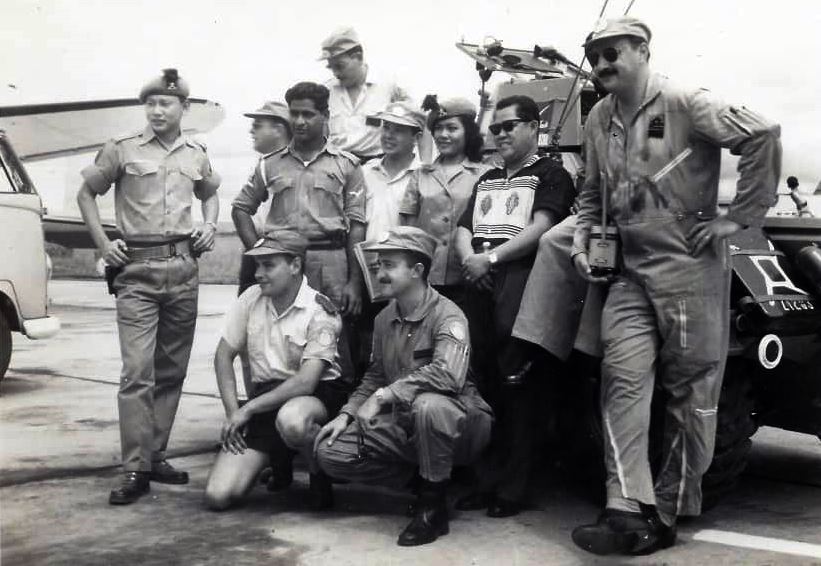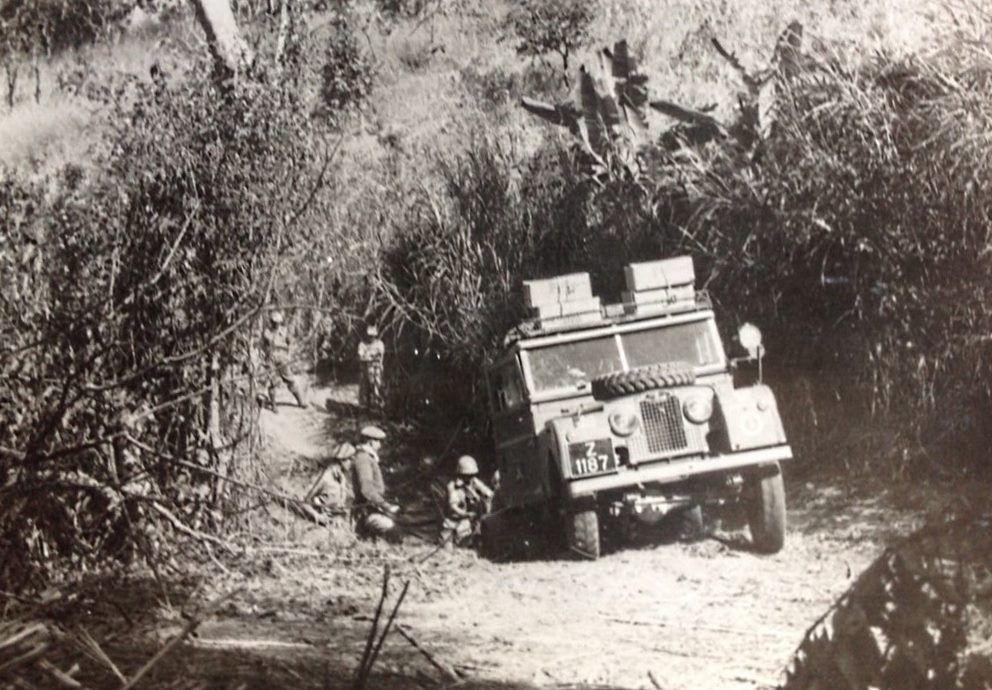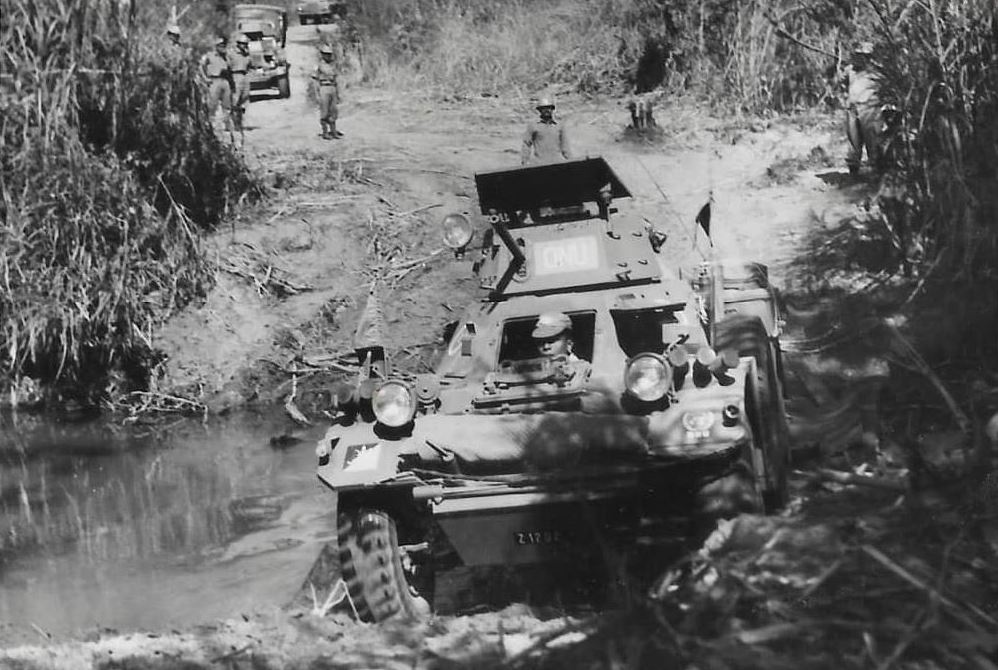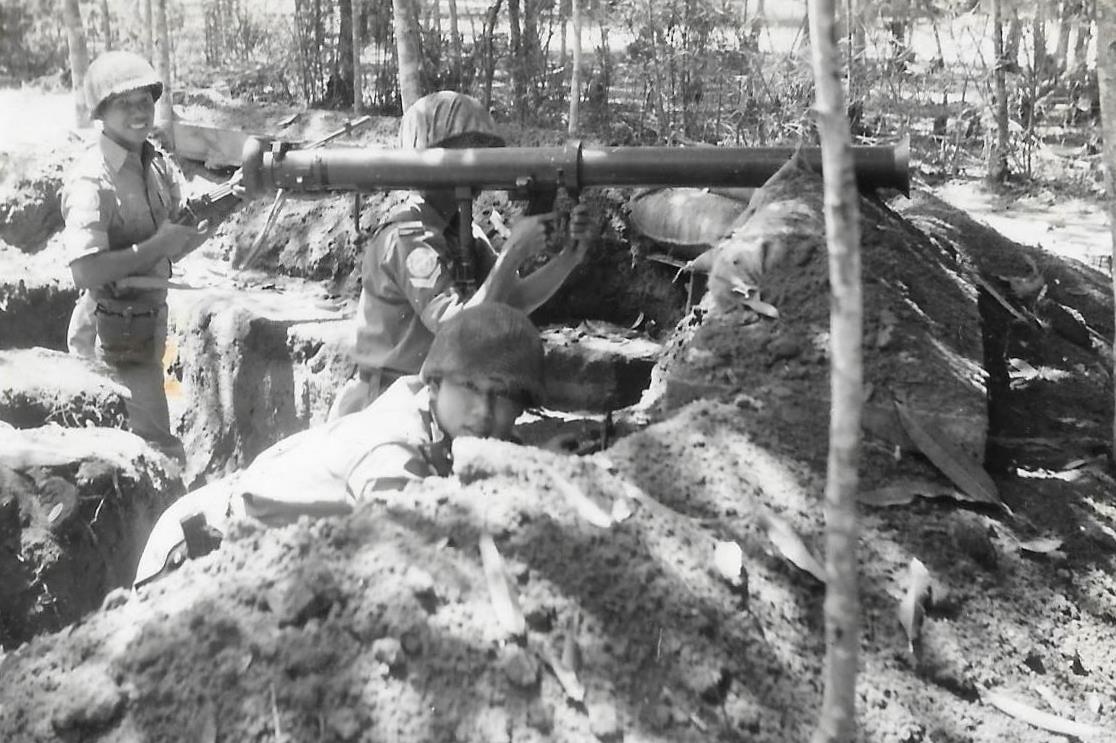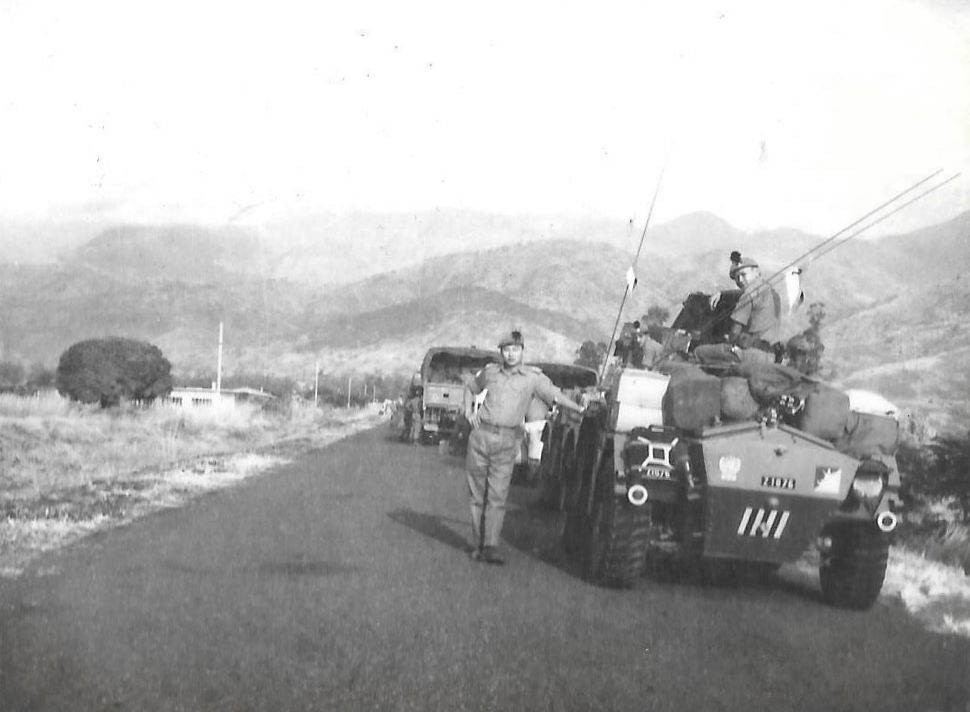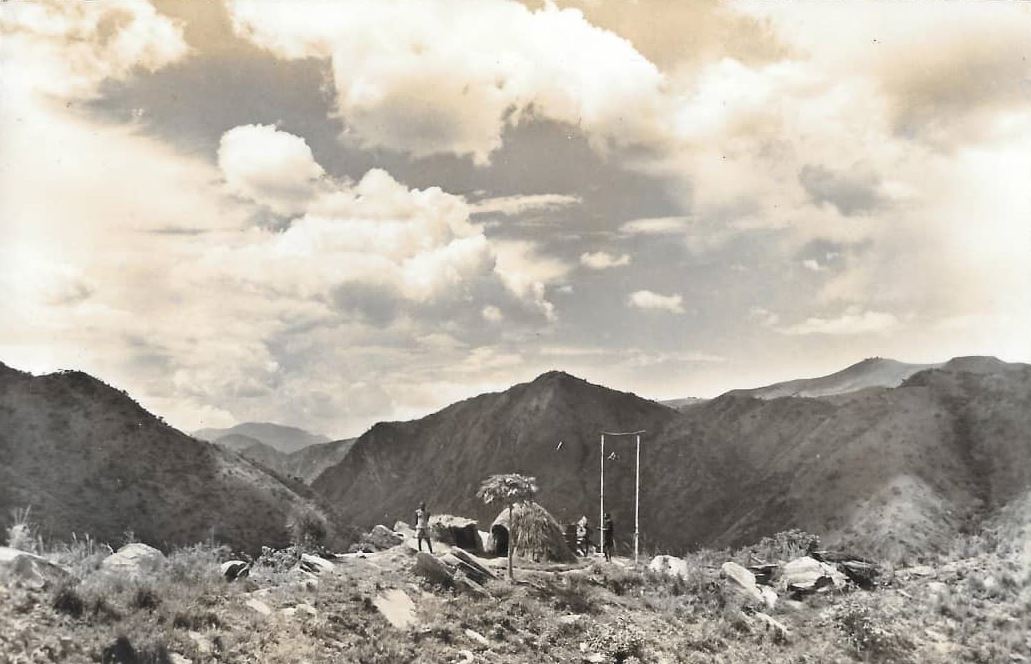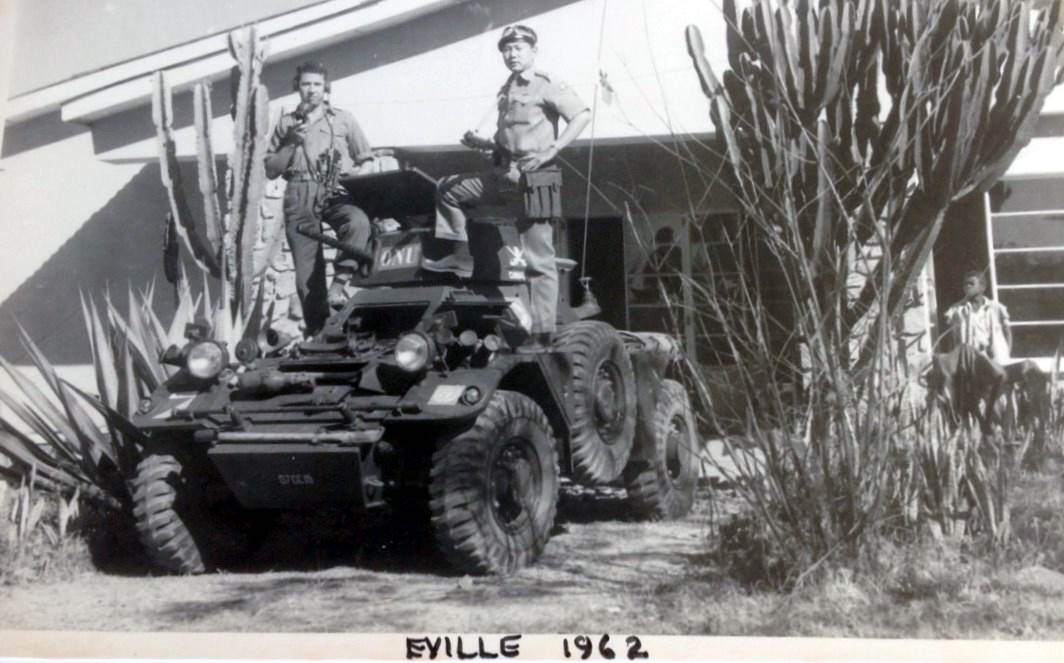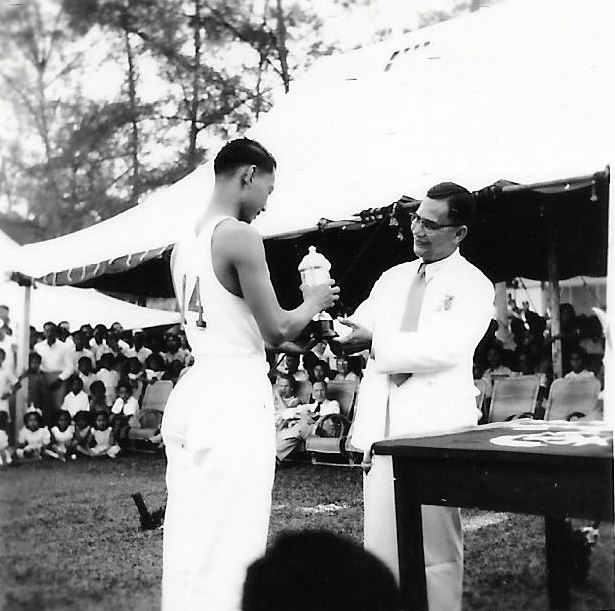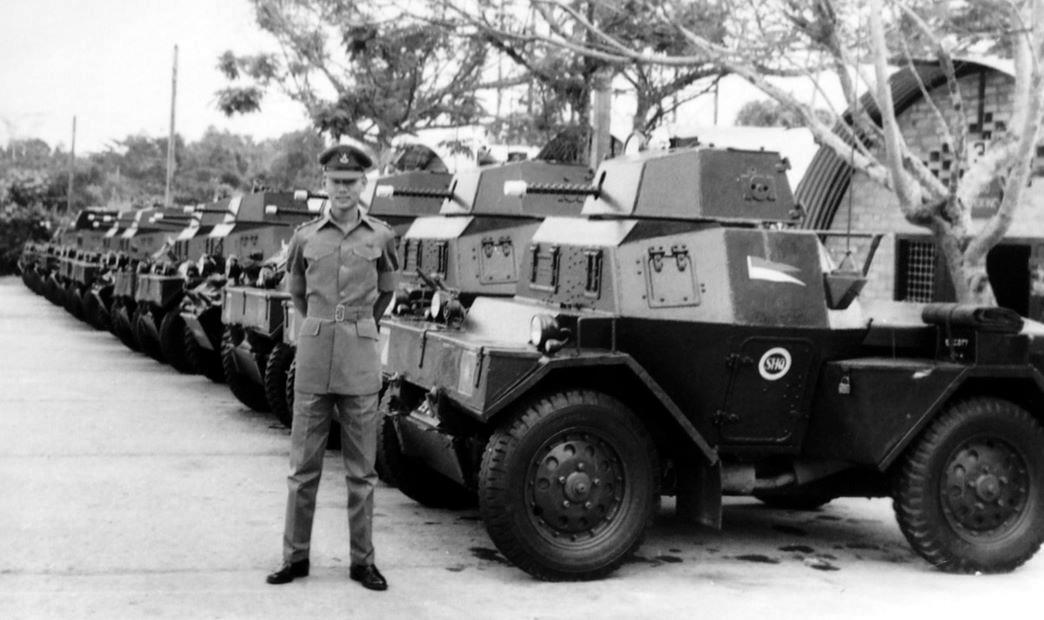|
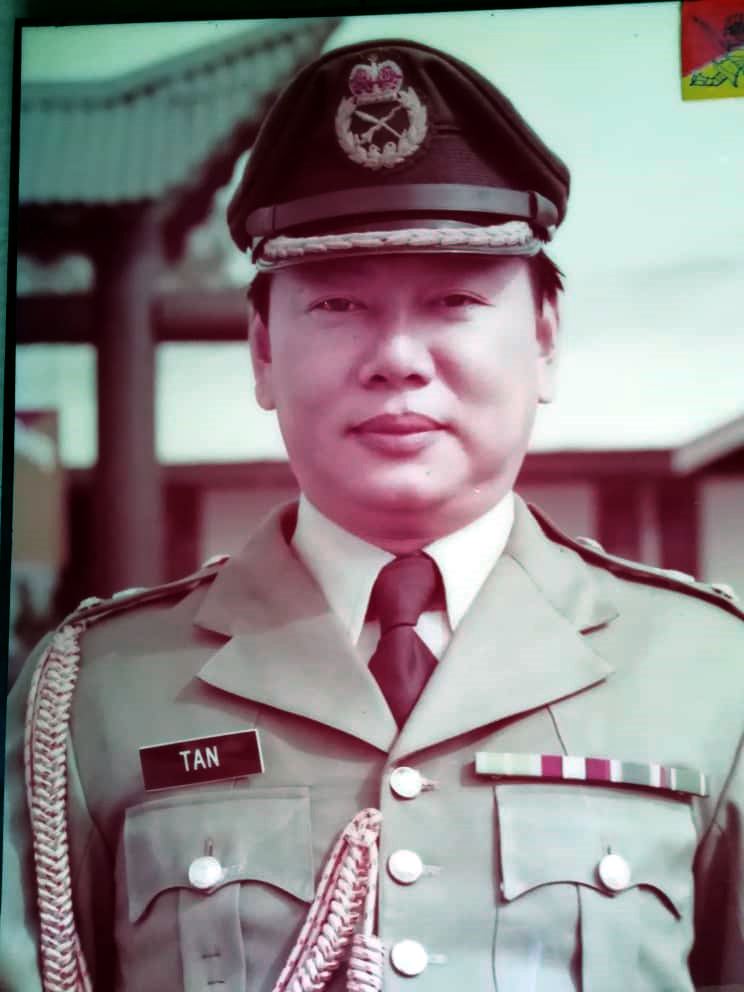 |
|
Lieutenant Colonel Tan Siew Soo (Retired)
KAT KMN AMT
Preface
The Democratic Republic of Congo, the second largest country in Africa received its independence from Belgium on 30 Jun 1960. Four days after independence on 4th July; the first mutiny of the Army occurred at the military Garrison in Thysville. This mutiny was pacified by both the President and the Prime Minister. The next day; troops at the biggest camp in Leopoldville gathered to air their grievances. The Belgian officers attempted to break up the meeting but were arrested instead. On 6th July; a delegation of soldiers met their Prime Minister, Lumumba and demanded the departure of their Belgian officers, a pay rise and promotion. The request was rejected at first but after assessing the seriousness of the situation, the Prime Minister fired the Belgian Commander of the Army and announced a one rank promotion for the entire army whereupon it became the only army in the world without a Private soldier !
On 9 Jul 1960; the mutiny spread to other parts of the country. There were widespread looting, destruction of property and many Europeans were killed and injured. This brought about the Belgians intervention on 10th July; to protect Belgian lives and vested interests. On 11th July, both the President and the Prime Minister appealed to the United Nations for an urgent dispatch of a UN military force to help restore peace from the fast deteriorating chaotic conditions. The first UN force arrived on 15th July in Leopoldville made up of Ghanaian and Tunisian contingents, soon followed by others.
Our United Nations Operations in the Congo took place from September 1960 to May 1963. This was a most glorious chapter in the annals of our Army and the Country, truly serving King and Country and showing a young Malaysia to the world. In early August 1960; an urgent request was received by the Prime Minister Tengku Abdul Rahman requesting our troops to be sent to the newly independent, but strife-torn, chaotic Congo. After some changes, the Malayan contingent eventually settled at 42 Officers and 571 Other Ranks comprising:-
a. 4th Battalion Royal Malay Regiment (4 RAMD) consisting of 3 X Rifle Companies (Coy).
b. C Squadron 2nd Reconnaissance Regiment (C Sqn 2 Recce) boosted up with 1 X Scout Troop from 1st Reconnaissance Regiment.
c. One Signal Troop from the Signals Regiment.
d. Elements of Supply & Transport, Ordnance and Workshop.
e. Reinforced HQ Coy making up the Force HQ.
This special force was designated the Malayan Special Force (MSF) and the man given the honour to command was Lieutenant Colonel (Lt Col) Ungku Nazaruddin (Bruno) bin Ungku Mohamad while Major (Maj) Zain Hashim led the Reconnaissance Squadron. On 13 Sep 1960 the units marry up at Imphal Camp, near Ministry of Defence (MINDEF) for a two week intensive training. The entire MSF was transported by 2 American Landing Ship Tank (LST), 1169 and 1170 on a most memorable nonstop voyage round the Cape of Good Hope to the Port of Matadi, Congo in darkest Africa. At the peak of this UN Operations, Malaya committed 30% of it's Army to ONUC (Organisation des Nations Unies au Congo). Lt Col Tan Siew Soo was privileged to serve 2 tours in Congo and he authoured the book The Malaysian Special Force in the Heart of Africa which was published in 1989, a year before his retirement in November 1990.
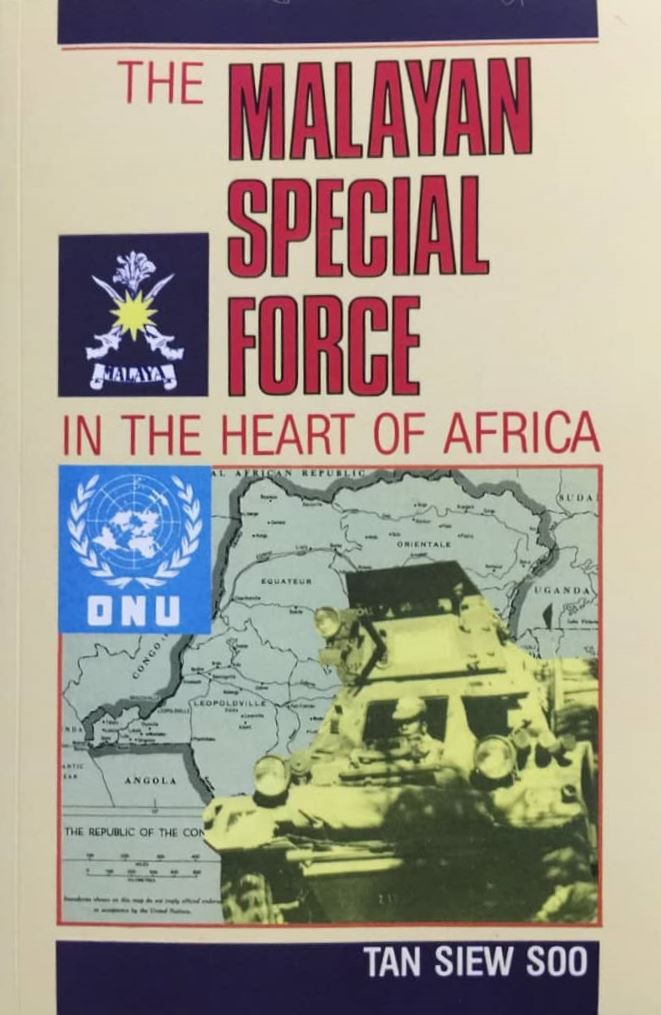 |
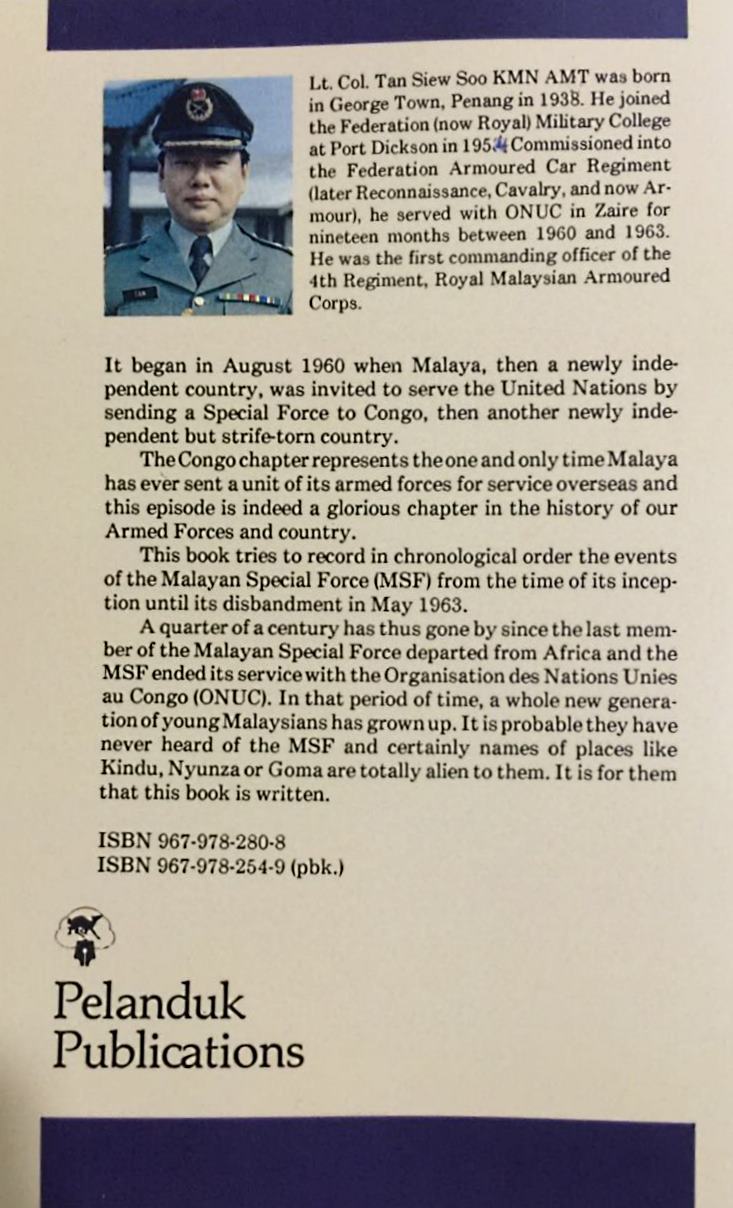 |
ONUC First Tour - September 1960 to July 1961
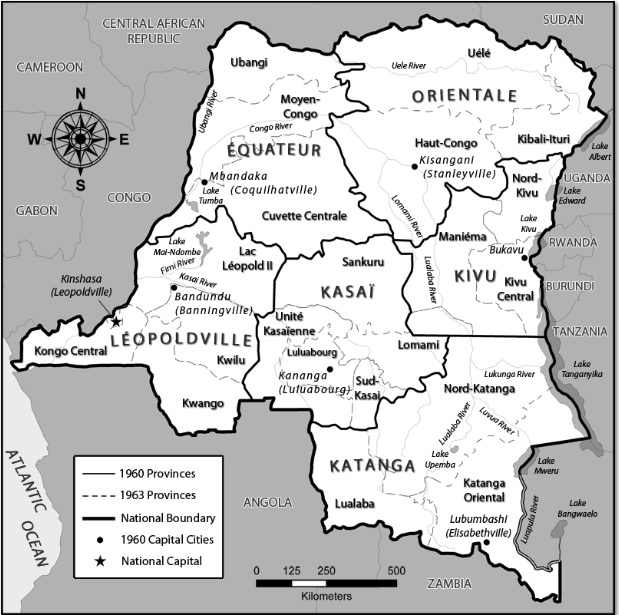 |
| Democratic Republic Congo 1960. Source: https://aarclibrary.org/ |
C Sqn 2 Recce MSF departed from Woodlands, Singapore on 2 Oct 1960 on a 28 day’s journey. The last leg of the voyage was the smoothest. Sailing up the mighty Congo from the Atlantic Ocean in the early hours of 31 Oct 1960 for the Port of Matadi which is situated 160 km up river. Landed at Matadi around 1700 hours where waiting was a Moroccan Guard of Honour. Lt Col Bruno Ungku Nazaruddin, the Commanding Officer (CO) of MSF took the salute and inspection.
Formality over, unloading of vehicles from the LSTs began in earnest. The city of Leopoldville (now Kinshasa), C Sqn final destination was another 365km away. Three separate trains were scheduled to lift the entire MSF into the capital city. The first train departing at midnight ferried all the Infantry element and the Rifle Troop (Tp) of C Sqn. The second train departed at 0130 hours on 2nd November carried all the Ferret Scout Cars. The Troop leaders were:-
a. No 1 Tp - Second Lieutenant (2nd Lt) Tan Siew Soo.
b. No 2 Tp - 2nd Lt Philip Lee Khui Fui.
c. No 3 Tp - 2nd Lt Tee Bua Bian.
d. No 4 Tp - 2nd Lt Teoh Say Chee.
This train consisted of open wagons and each wagon carried 2 Ferret Scout Cars. At the speed the train was travelling, it was near miracle no Ferret left the coaches. The first train encountered a derailment before entering the city and it was sheer luck there was no casualty. Due to this, the second train was halted for a few hours at a small railway station KM 236. There was an ongoing Rail and Port strikes and the Sqn were stranded for a while. The Ferret Scout Cars finally were unloaded using the Sqn initiative and expertise of the EME (Electric & Mechanical Engineer Corps) personnel.
At about 1600 hours on 4 Nov 1960, all the Ferrets lined up and drove past 'Le Royale', HQ ONUC enroute to our very first camp, Ozone Camp. This was an excellent PR exercise to showcase the Armoured element of the MSF to the UN HQ and the local populace. No 'B' vehicles, only the 18 Ferret Scout Cars driving in a single file. The irony was it was led by a soft skinned Volkswagen Beetle, driven by Major Desmond Furney, an Irishman seconded to 1 Recce and was employed at HQ ONUC as the MSF Senior Liaison Officer.
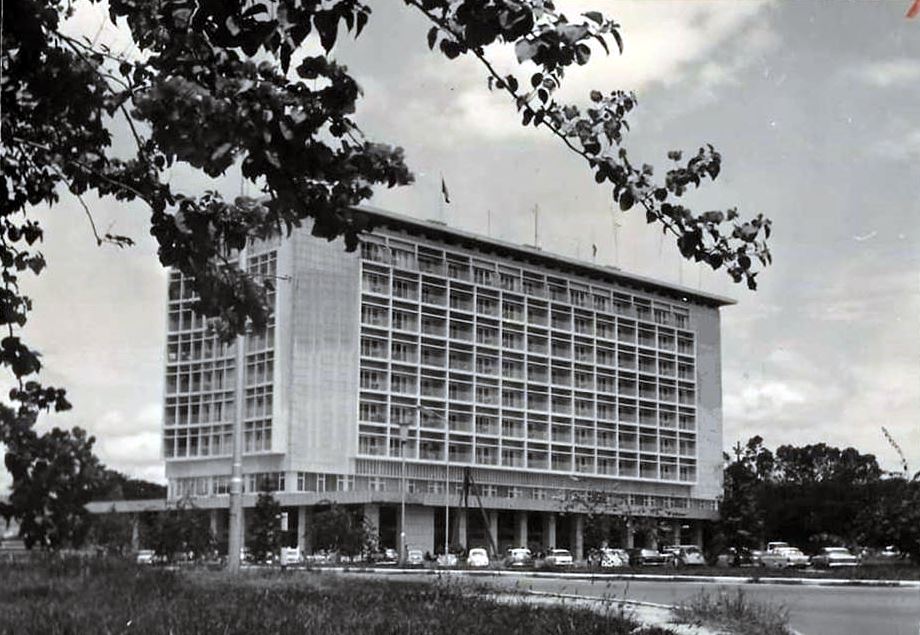 |
| ONUC HQ, formerly ‘Hotel Le Royale’. |
The Volkswagen was the leading scout to a long thin line of Port Dickson Green Ferret Scout Cars. Maj Zain Hashim led in the first Ferret, 2nd Lt Tan Siew Soo at the 3rd Ferret, 2nd Lt Philip Lee Khui Fui at the 7th Ferret, 2nd Lt Tee Bua Bian at the 11th Ferret and 2nd Lt Teoh Say Chee at the 15th Ferret. Unknown to most of us at that time, Lt Gen Carl Van Horn, the UN Supreme Commander appeared smiling at the window on the 6th Floor. What was more obvious and very touching was clearly the friendly wave of hands by the many UN staff particularly the secretaries who had gathered at the balcony to greet us. It is occasion like this that makes one feel extremely proud of the uniform and the Regiment to which one belonged !
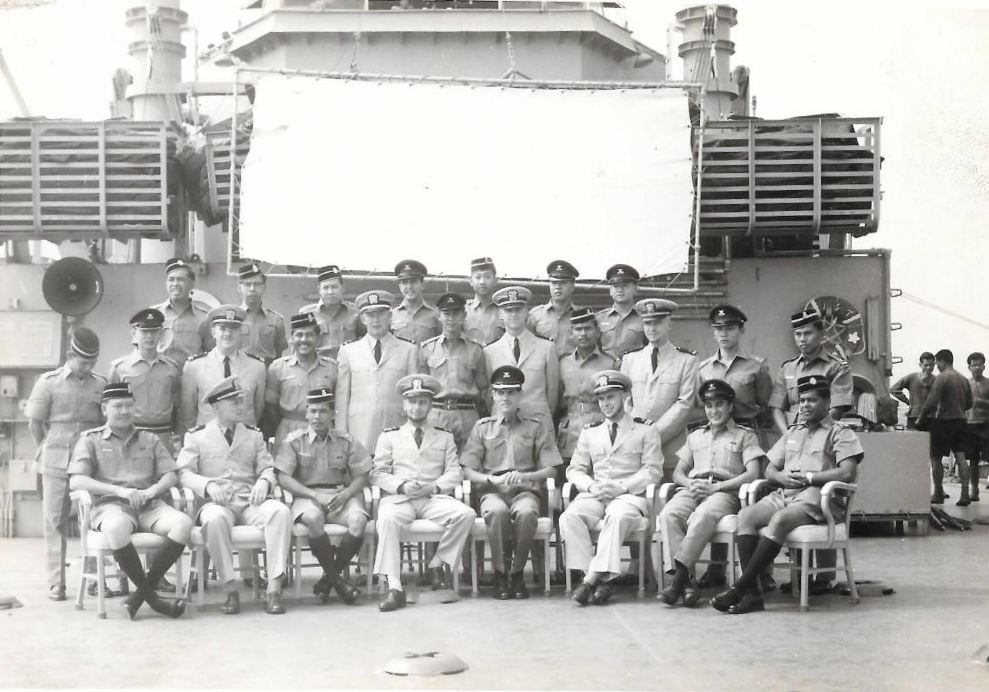 |
Group photo of half of the MSF Officers
Seated L to R: Capt Loh Sai Kee, USN, Maj Robert Mahmud Yusoff, USN Lt Comdr (Capt of LST), Maj Zain Hashim, USN, Capt E Rodriques, Capt (Dr) Denis Lopes.
Centre Row: Capt Zainal Dato Ahmad (Chetty), 2/Lt Tan Siew Soo, USN, Capt C Dorairaju, USN, Lt Tunku Ahmad Nerang, USN, 2/Lt Ahmad Che Wan, USN, 2/Lt Tee Bua Bian, 2/Lt Annuar Hashim.
3rd Row: Hon Lt Amir Shamsuddin (MFU), Lt Omar Musajee, Hon Lt Syed Alwi Syed Hassan (Radio Malaya), Lt JC Rodriques, 2/Lt Aziz Saif, 2/Lt Teoh Say Chee and 2/Lt Philip Lee Khui Fui. |
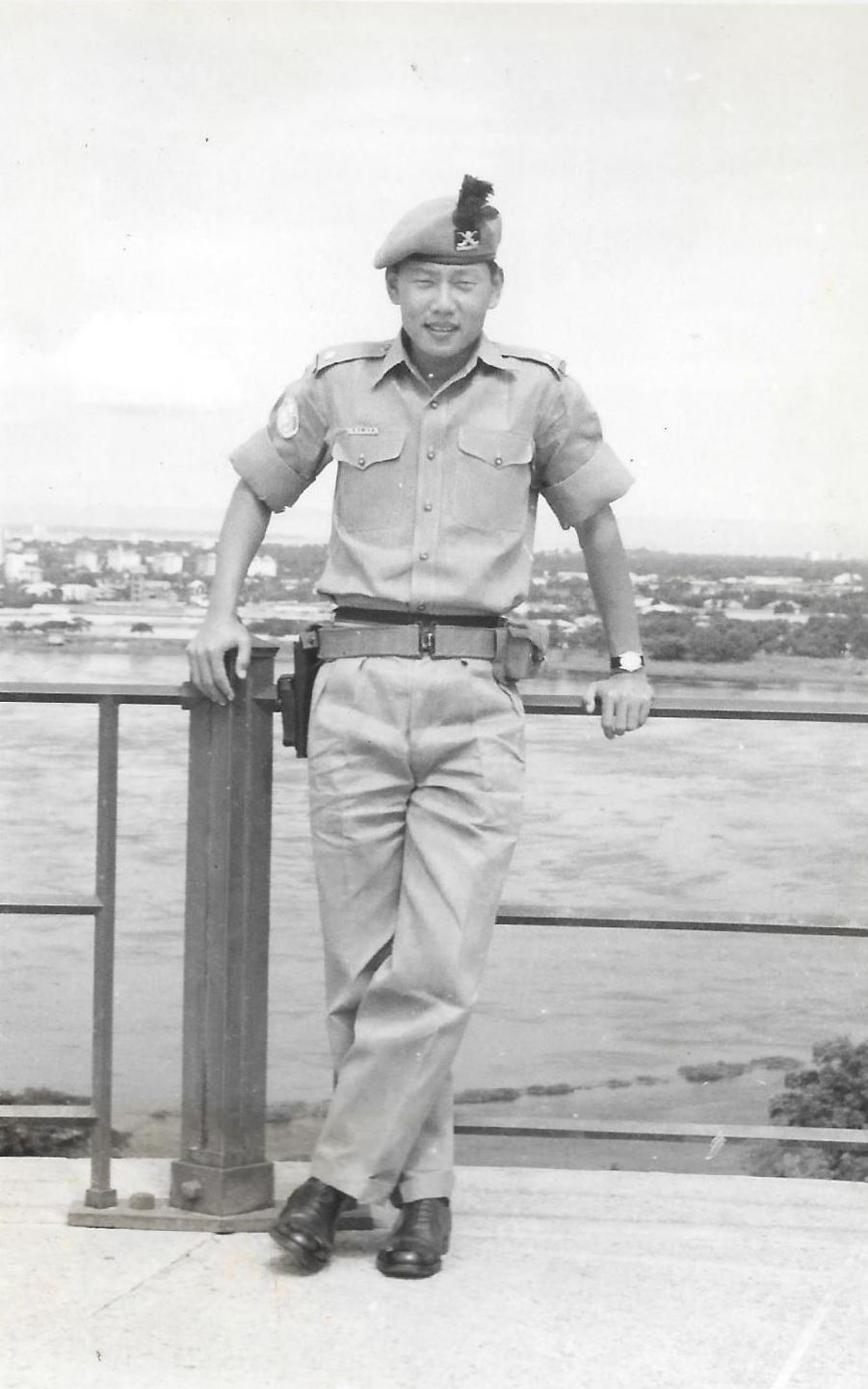 |
| 2/Lt Tan Siew Soo, Leopoldville, Congo. early November 1960. |
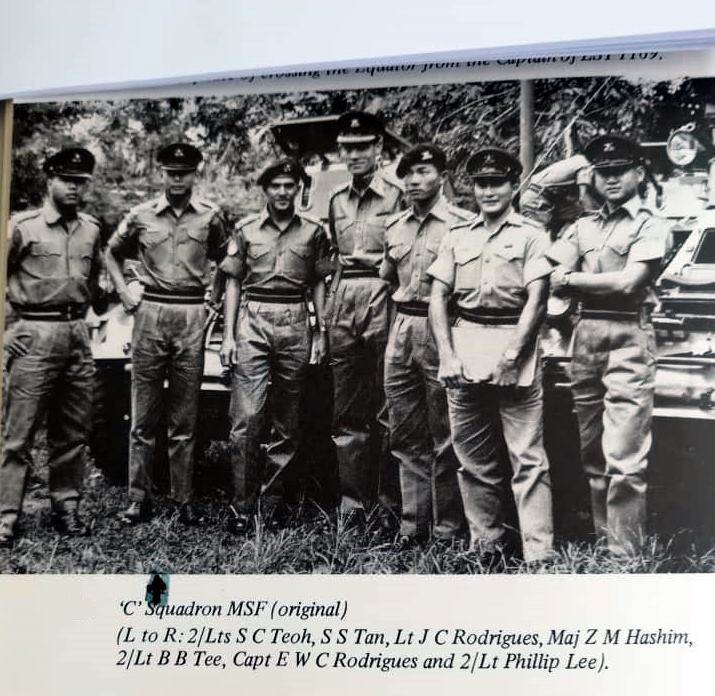 |
| 4 Chinese officers out of a full complement of 7 in the Recce Sqn MSF. Photo taken during first week of November 1960 at the first MSF Camp (Ozone Camp) Leopoldville. |
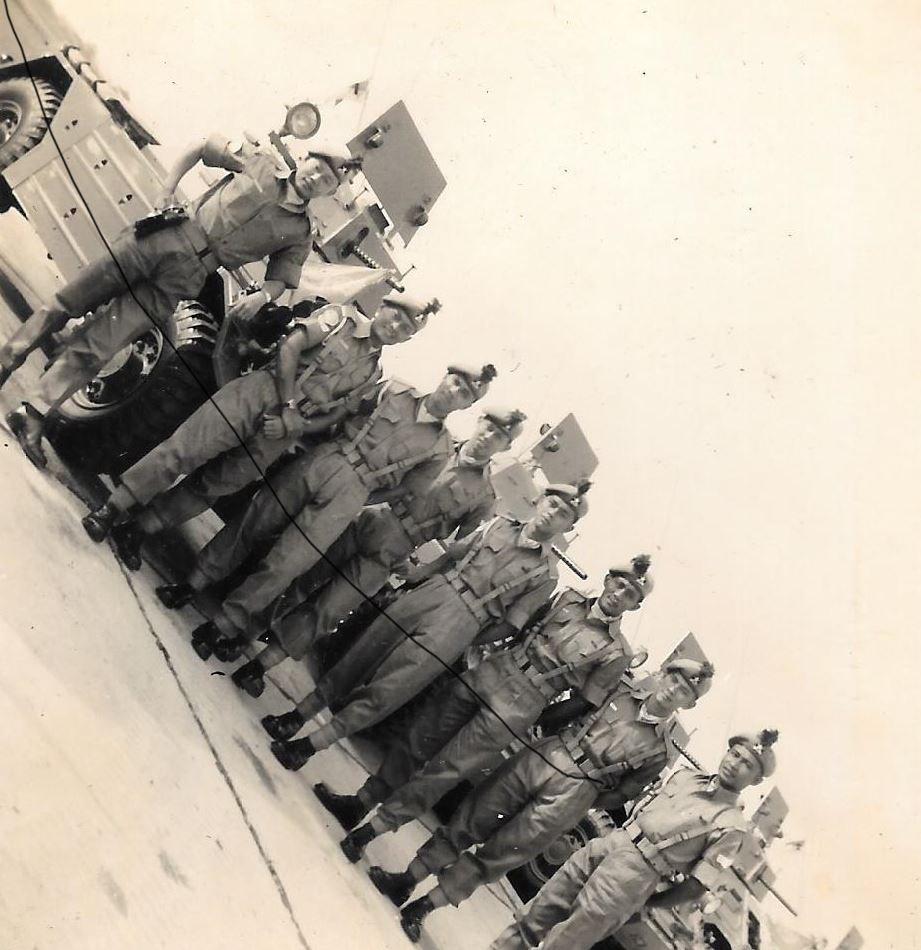 |
| No 1 Scout Tp, C Sqn MSF. L to R: 2/Lt Tan Siew Soo, Cpl Musa, Tpr Tarihuddin, Cpl David Lam, Tpr Skading, Tpr Nordin, Tpr Moi Wah and Sgt Ahad. They are 3 MACVs in this photo. 50% Non Malays, 4 out of 8. |
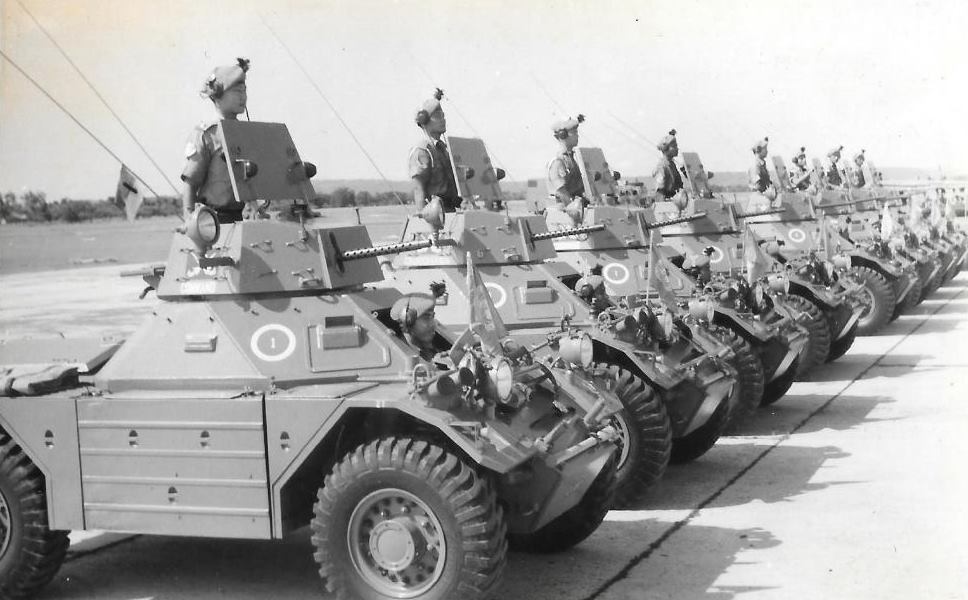 |
| 9 Dec 1960, the impeccable and extremely impressive Presentation Parade to the UN Supreme Commander, Lt Gen Carl Von Horn. |
The White Circle ring denotes C Sqn and the Figure 1 inside it denotes No 1 Tp. This was standardised in all Armoured regiments of the Commonwealth armies. There were a total of 18 Ferret Scout cars (2 in Sqn HQ) in C Sqn, the most ever in a Recce Squadron. They were without doubt the major forces in the MSF. The Ferret scout cars inspired respect and struck fear among the Congolese soldiers. With their good discipline and smart turnout all the time; they were successfully carrying out pacification operations in many troubled areas in many regions.
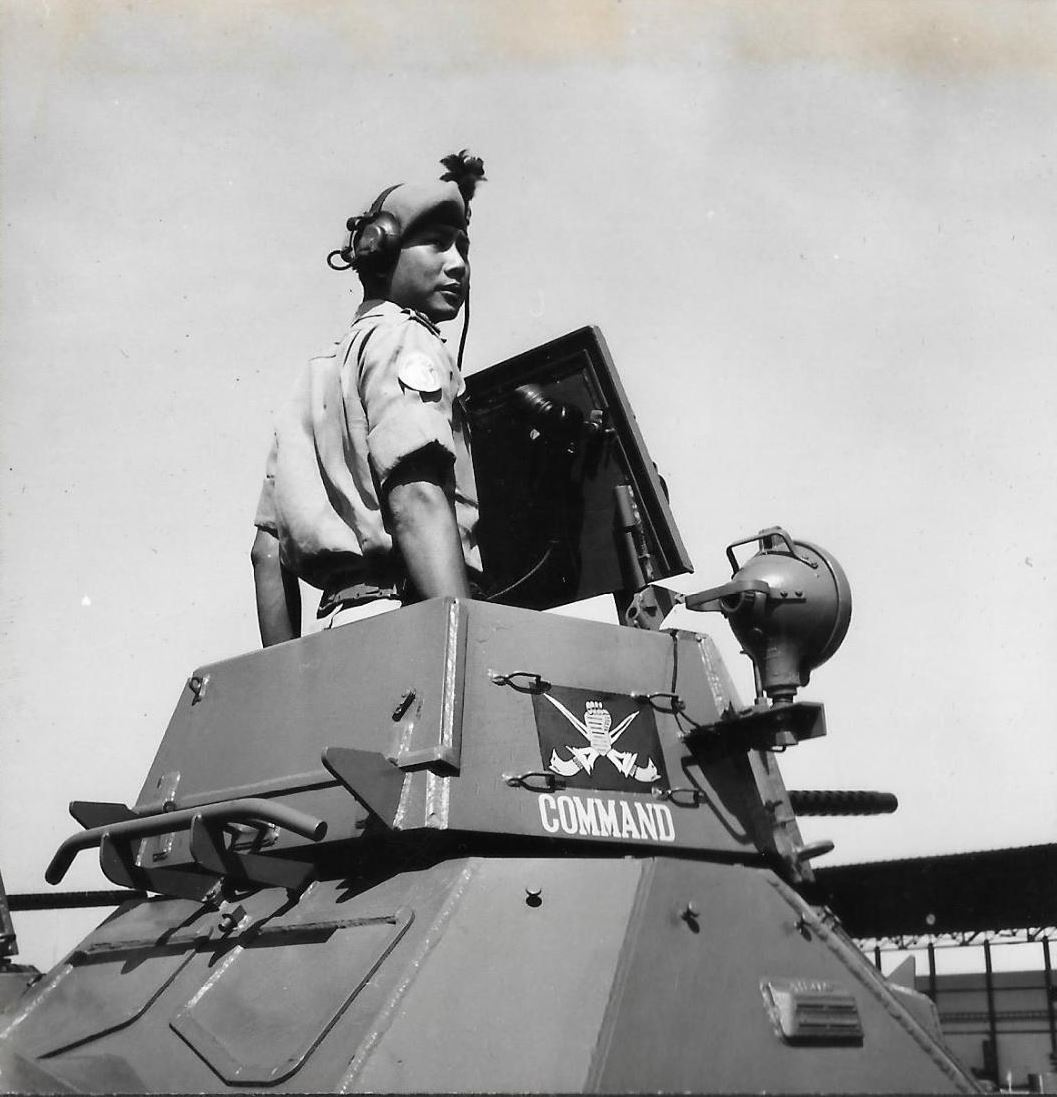 |
This picture was taken by a UN photographer for UN publication, a fortnightly newsletter called Tom Tom in English and Tam Tam in French on the reverse. Full view of Siew Soo’s Ferret Scout Car which he called "Command" but the second time around he named it "China Doll". Note that all names must begin with C. Notice the UN flag above the headlight, this flag flew with Siew Soo everywhere on patrolling. The historical flag is now part of his valued possession.
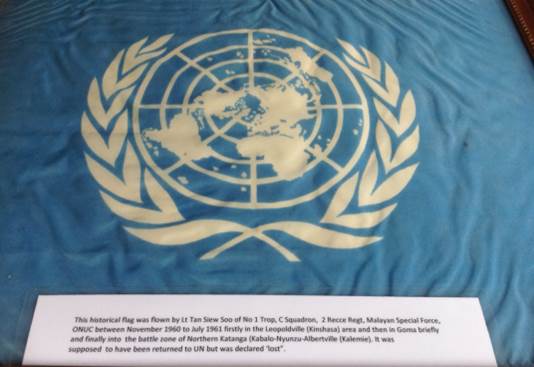 |
The Early Chaotic Days in Leopoldville
The MSF arrived in Leopoldville in November 1960. By then the Congolese Army Chief of Staff, Col Joseph Mobutu had declared himself the new “Strongman" of Congo. He put the Prime Minister, Lumumba under house arrest and declared the Ghanian Ambassador "persona non grata" and ordered him to leave the country in 48 hours. The Ambassador was defiant because he had a Platoon of Tunisians guarding his residence. The situation exploded on the night of 21st November and a battle took place between the UN Tunisians and the Congolese Army. The shooting was wild and indiscriminate. The whole sky lighted up like fireworks with tracers flying all over.
In the midst of the fighting, the Congolese brought in one of their Greyhound Armored Car armed with a 37 MM gun. The neighbouring house next to the Ambassador was the Canadian Signals Regiment Officer's Mess. The Officers were having dinner. In the heat of the battle the Greyhound let fly one round meant for the Ghanaian but due to poor gunnery (obviously no T&A done) the shot hit the Canadian Officers Mess and caused a total blackout. The Officers dived for cover, end of dinner !
2nd Lt Tan Siew Soo was Duty Officer, the only Officer holding the fort in Camp Chanic, about one km from the battle scene. All MSF officers were at the Officers Mess about 5 km away. From the UN side nothing moved during that night. One Tunisian Commander approached Siew Soo and requested the Ferret Scout Cars be deployed. He was asked to refer to the OC, Maj Zain Hashim.
Next morning a ceasefire was arranged. There were many casualties on both sides but only 2 Tunisians KIA and the Congolese lost 4 but it included the Leopoldville Garrison Commander, Col NKokolo.(Camp Leopold, the biggest camp was later renamed Camp NKokolo in his honour.)
After the fighting, tensions heightened and hot rumours swirling in the Capital indicated the Congolese was planning to attack the UN HQ. Immediately ONUC ordered one Rifle Coy and one Scout Tp be deployed at the basement of "Le Royale" rotating every 48 hours. Not a very healthy location to be in, the soldiers quickly nicknamed the place “the Dungeon".
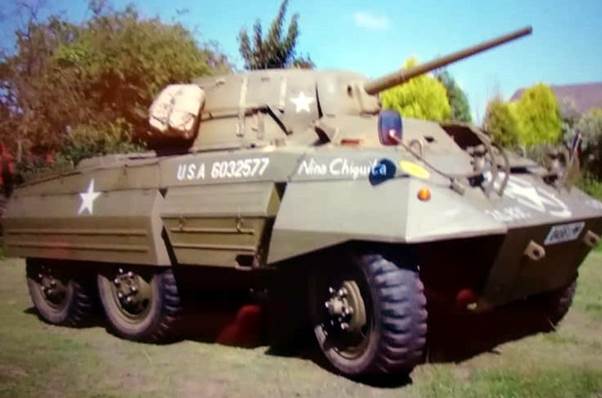 |
| The Greyhound Armored Car similar to the ones operated by the Congolese Army. |
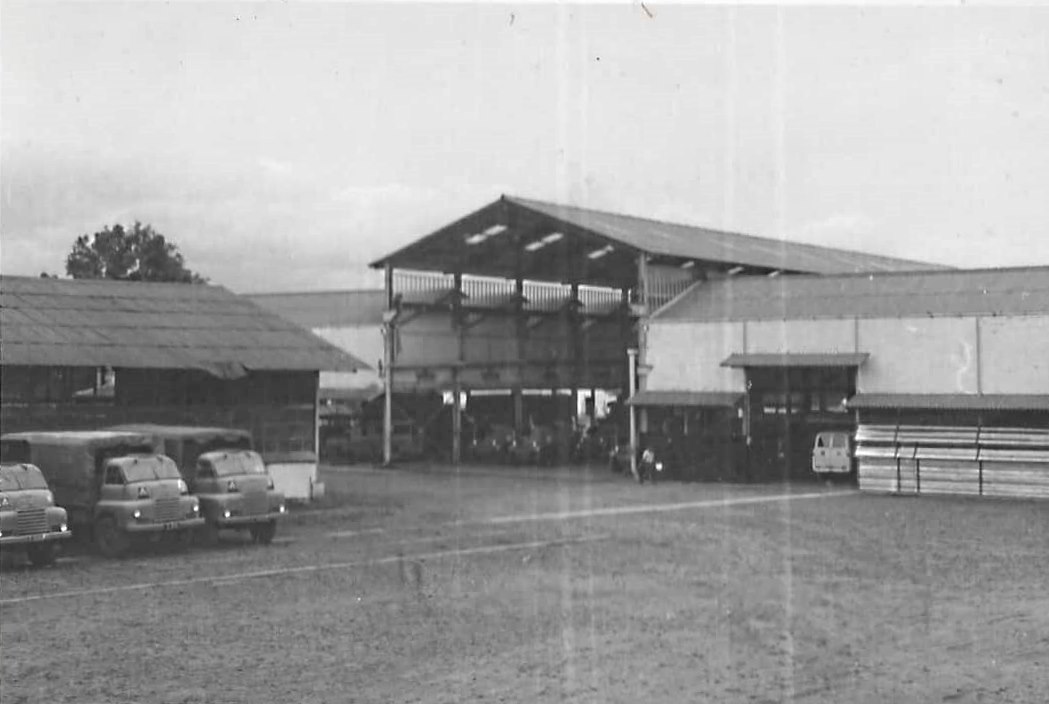 |
| Chanic Camp, Leopoldville. |
| On 3 Apr 1961, Malaysian Government dispatched an Entertainment Troupe to the Congo. They also entertained other UN contingents, transported by the Italian Air Force around the country. Seen here were actress/singer Hashimah Yon and leader of troupe, Ismail Bontak. |
| The type of terrain C Sqn MSF encountered once outside towns. This is on the main road from Nyunzu to Albertville taken during their move on 17 May 1961. Notice the tall elephant grass. Not far from here on 8 Nov 1960, 9 Irish soldiers traveling in two Jeeps were killed by wild Baluba tribesmen in an ambush. |
| No problem for Siew Soo's ferret crossing the same spot as the Land Rover. |
| “Stand To" in Nyunzu, the battle zone of Northern Katanga in May 1961. "Stand To" is a code word for getting into battle positions ready for an attack, a British tradition. This daily routine is carried out during first light (dawn) and last light (twilight) with no exception. |
Reentering Congo from Burundi
| On 20 Jun 1961, C Sqn MSF moved to Bukavu from Albertville via Usumbura. There halted at the border before reentering the Congo from Burundi, notice the mountainous terrain and the nice road of Burundi. Lt Tan Siew Soo standing and Lt Philip Lee at the tail end Charlie. |
| The scenery along the mountainous road from Usumbura to Bukavu. |
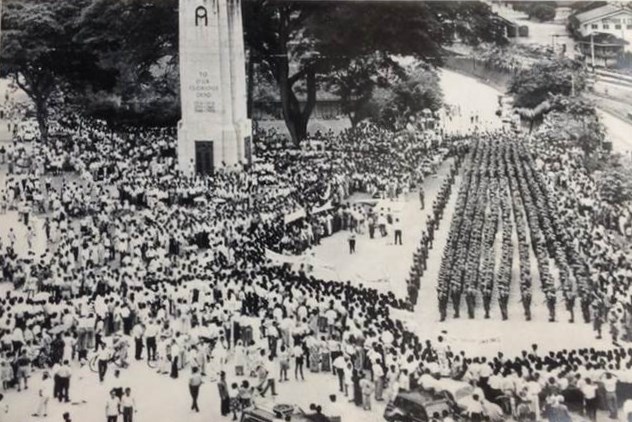 |
| The Public welcoming back the MSF at Kuala Lumpur on 30 Jul 1961. |
On 30 Jul 1961, the original MSF having arrived at Port Klang the night before; boarded a special train for Kuala Lumpur. All along the 40 km route on both sides of the track was a truly amazing sight, one super-duper continuous hands waving people who came out of their houses to cheer the home coming soldiers. This patriotic gesture really touched the hearts of every personnel in the train. This spontaneous genuine show of appreciation for the MSF must be the epitome of rewards for soldiering if there is one.
Arriving at the Railway Station there was a large crowd with placards welcoming the MSF home. Following an address by the Defence Minister Tun Abdul Razak, the original MSF parted company, 4 RAMD going home to Mentakab and C Sqn 2 Recce to Sungala Camp, Port Dickson.
On 21 Sept 1961, C Sqn 2 Recce with a total of only 100 all ranks was granted a rare and unique honour by the King while the rest of the Regiment was still in the Congo. A Royal Review by the King at Sungala Camp, Port Dickson given to a sub unit of the Army is one of a kind; it has never happened since and unlikely will happen again. An interesting point to note after the King’s inspection and address were over it was a simple 3 Cheers for His Majesty: Hip Hip Hooray (3 times). The words of command were still in English then.
C Sqn may be only 100 strong but it had quality personnel. From the Chinese personnel alone 3 NCOs were later commissioned as officers into the Artillery Regiment which were Corporal (Cpl) David Lam, Cpl Tony Chia Eng Lim and Cpl Ng Soo Teong, all became excellent officers in their new Corps.
The original MSF indeed earned itself and the country a very good name and great honour. The speech by the UN Supreme Commander, General Sean McKeon who personally came to present the Congo medal at the Farewell Parade of this MSF says it all.
Excerpts:
"....you have been given many difficult assignments since your arrival in November last year. These tasks have been performed in a magnificent manner. It has been a pleasure to deal with you and to see the readiness with which orders were accepted and carried out efficiently. You have every right to return to Malaya, proud in the knowledge that you have give a good account of yourself. I hope your people, your army and your country will come to know fully of the very fine record you have gained for yourselves here in the cause of peace in the Congo and indeed peace in the world as a whole......".
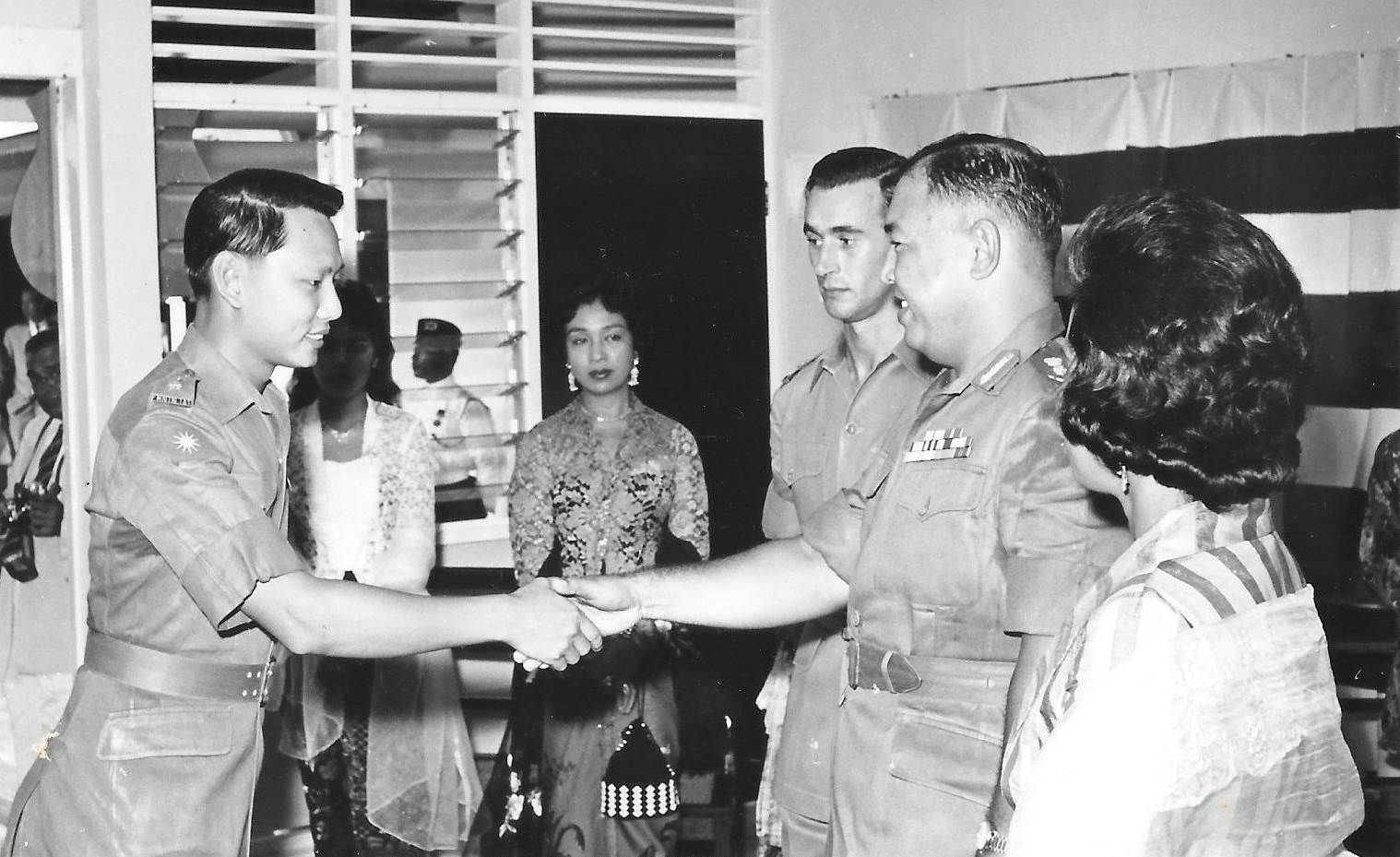 |
| Lt Tan Siew Soo Presented to the King the First Time upon return from the Congo. |
ONUC Second Tour - June 1962 to April 1963
C Sqn 2 Recce was back home in Sungala Camp, Port Dickson since August 1961 was joined by the rest of the Regiment returning from the Congo at the end of January 1962. However, on 16 Jun 1962, after a break of about ten months, C Sqn was back for service in the Congo teaming up with 2 RAMD less D Coy.
The Squadron was granted another Royal Review by the King. C Sqn 2 Recce was indeed a blessed Squadron. It was and still is the only sub unit in the history of the Army ever to be reviewed by the King on its arrival home from the Congo. The King once again went down to Sungala Camp, Port Dickson to bid farewell to C Squadron who returned to the Congo a second time in less than a year, the only unit in the Army to do a two tour duty with the ONUC. For the Second Tour it had 3 X Scout Troop and one Rifle Troop.
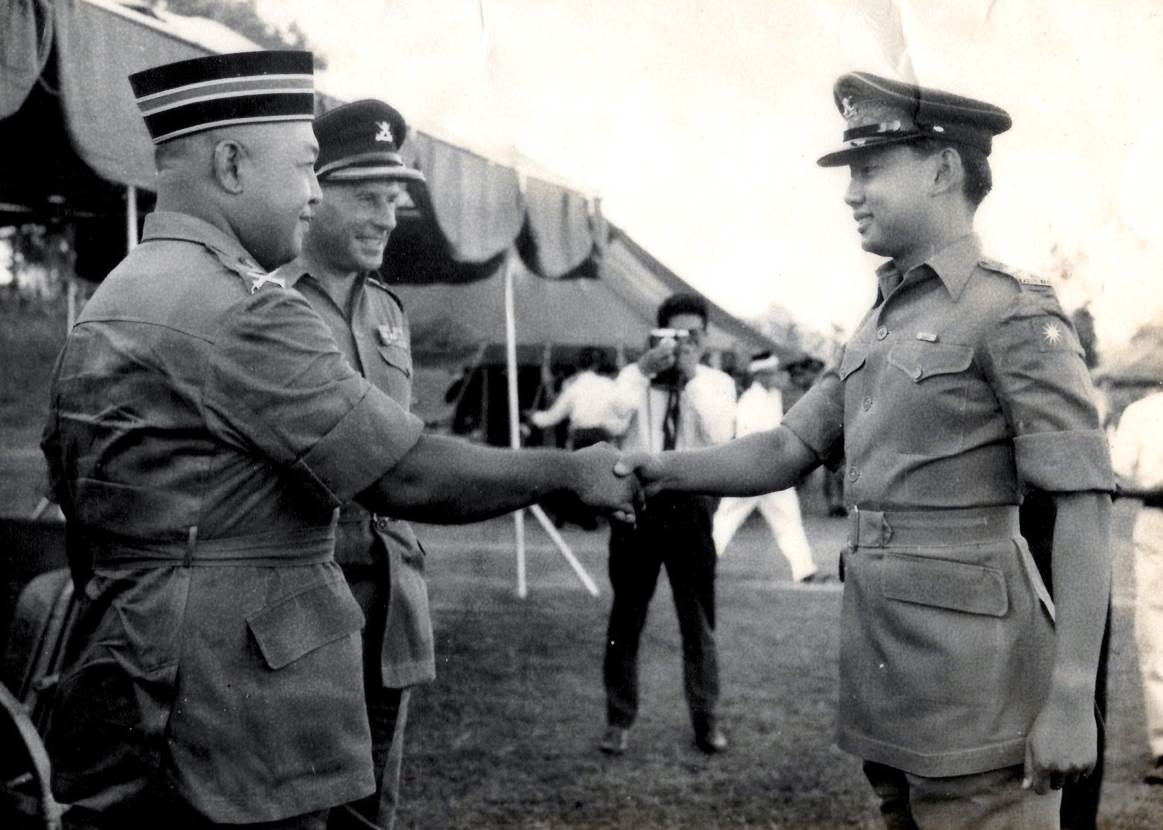 |
| Lt Tan Siew Soo Presented to the King the Second Time at Sungala Camp prior to Departure for the Congo in June 1962. Looking on was Lt Col Roger Nixon, CO 2 Recce. |
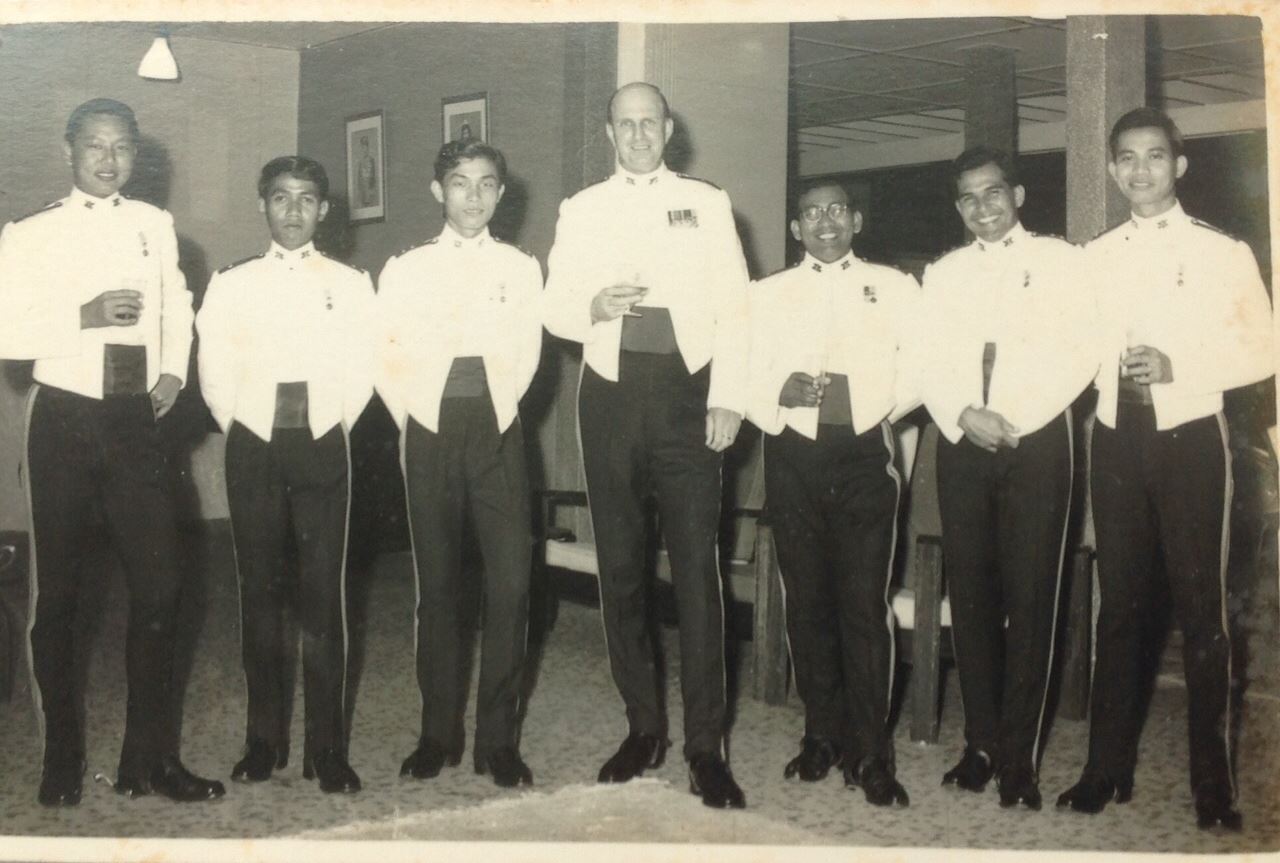 |
| C Squadron 2 Recce Officers Prior to Leaving for the Congo the Second Time. |
C Sqn 2 Recce in Elisabethville
On 28 Jun 1962, the last group of MSF arrived at Mombasa, Kenya. At the airport 2 RAMD went to Bukavu and Goma while C Sqn 2 Recce flew into Elisabethville, the second city in the Congo situated about 4000 feet above sea level and had a distinct cool and dry season from May to September. During this time the streets with Jacaranda flowering trees made the place very beautiful. On first day out on patrol, Lt Tan Siew Soo was hit by the cold blasts which numbed his fingers. He thought he had experienced the cold of Goma and Bukavu from the previous tour but this mid -winter cold of Katanga caught all of them by surprise.
A phenomenon that grew out of the Second Katanga Fighting was the 'inner' and 'outer' cordons surrounding Elisabethville. The Katangese gendarmerie were allowed into the city but unarmed. The cordons to affect this were manned by the UN. Further away the Katangese sited their own cordon to prevent UN personnel from getting out.
In Elisabethville at this time the UN force level was:-
a. 3 X Indian Battalion.
b. 1 X Ethopian Battalion.
c. 1 X Tunisian Battalion.
d. 1 X Irish Battalion.
e. 3 X Cavalry Squadron (Indian, Irish and MSF).
f. 1 X Heavy Mortar Company.
C Sqn 2 Recce during this tour comprised 3 X Scout Troop and 1 X Rifle Troop:-
a. No 1 - Lt Tan Siew Soo.
b. No 2 - Lt Tee Bua Bian.
c. No 3 - Lt Lee Ah Pow.
d. No 4 - 2nd Lt Raja Aznin.
All troops in Elisabethville came under Katanga Command, headed by Maj Gen Prem Chand, an Indian professional soldier seconded to UN. He was a perfect example of a gentleman officer whose spoken English could shame many an Englishman. C Sqn was placed under command of HQ Indian Bde and the emphasis was preparation for war. Each Scout Tp was affiliated to an Indian Battalion and No 1 Tp was affiliated to 4th Bn Madras Regiment. At the beginning each Scout Troop was detached to its affiliated Battalion on a weekly basis. As the troops got to know the battalion well enough, it was placed on call at the Squadron Line. All units were located close by except the one at the Airport. Later, to prevent boredom the Scout Tp was placed in support of the Airport battalion was rotated on a daily basis. The main task was patrolling the numerous tracks on the outer perimeter of the Airport to prevent the Katangese from coming in.
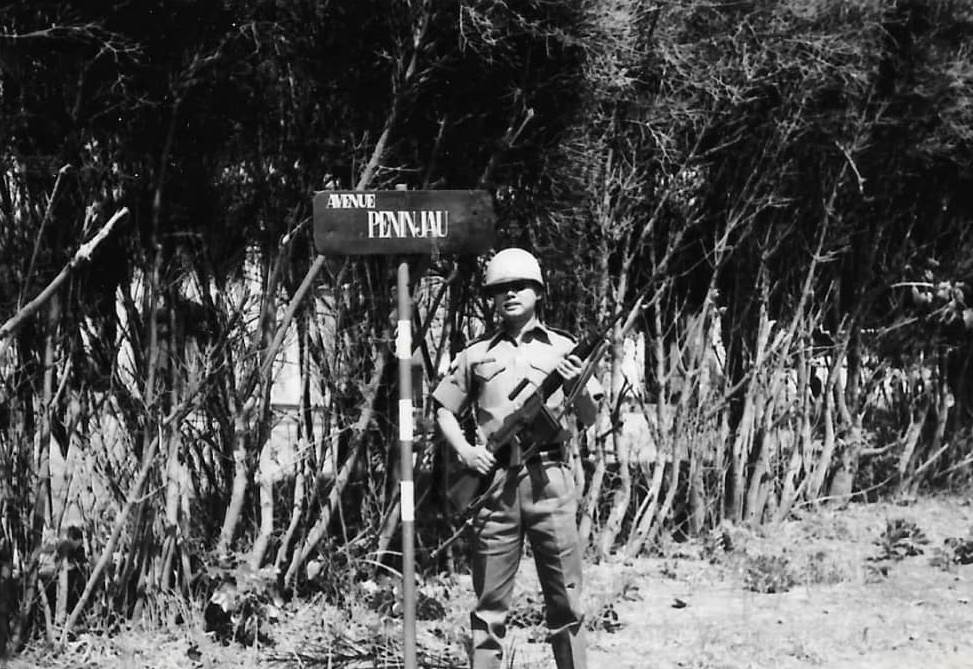 |
| The road beside the C Squadron Camp was named Avenue Peninjau ! |
| This was one of the houses used by the Tunisians guarding the Refugee Camp. This Tunisian soldier was very thrilled playing with Siew Soo's C12 headset. He had taken a break from patrolling the huge Refugee Camp which was guarded by UN Tunisian Battalion. |
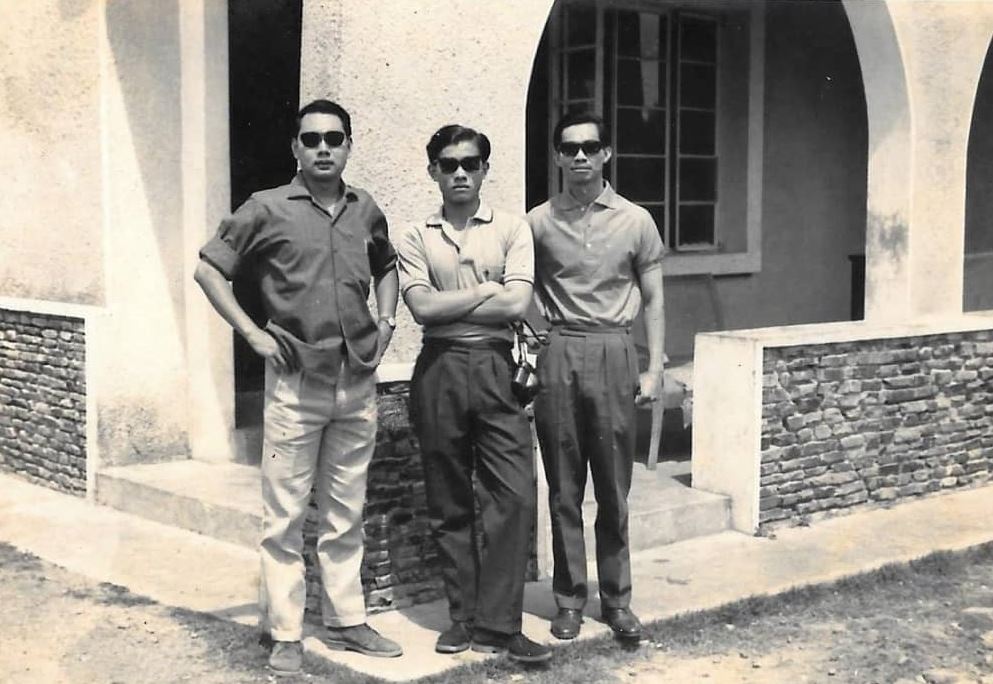 |
| The 3 Scout Troop Leaders of C Squadron in Elisabethville during a lull period. L to R: Tan Siew Soo, Tee Bua Bian and Lee Ah Pow. |
Missing The Action
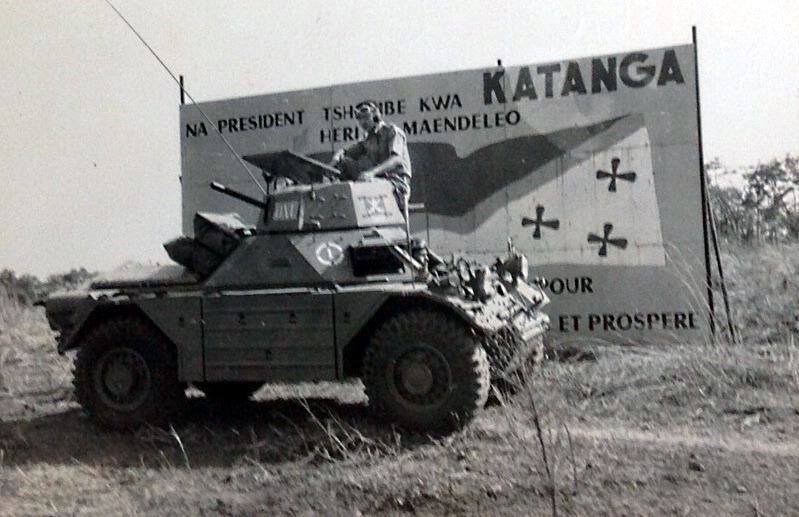 |
| Siew Soo on top of his Ferret in Katanga. |
Siew Soo served in Katanga from Jun to Dec 1962. It was a tumultuous period for the UN and it points to a 3rd Katanga War before Katanga was forcibly reintegrated with the rest of Congo. It therefore meant more training for war by the UN. No 1 Tp led by Siew Soo was affiliated to 4th Bn Madras Regiment and the mission given to this battle group was to capture Jadotville, an important copper mining town located 140 kilometers northwest of Elisabethville.
However C Sqn 2 Recce was denied the excitement and glory of the forthcoming fighting despite all their intensive training and preparations for war. On 3 Dec 1962, the Squadron was extracted out of Elisabethville and airlifted into Albertville. 3 X C124 Globemasters from USAF Transport Command took a total of 5 days to complete the move of C Sqn. During Major Asna farewell call on the GOC Katanga Command, Maj-Gen Prem Chand indicated that the move was engineered by Malaya UN Mission in New York.
C Sqn sojourn in Albertville and Siew Soo second tour lasted less than a month. They were ordered by HQ Bde MSF, who itself was in the process of packing up to join 2 RAMD at Bukavu. C Sqn handed over duties to the Indonesian Para Bn and departed Albertville. On 23 Dec 1962 the Squadron boarded the familiar Lake Barge for a two day voyage on Lake Tanganyika. This time around it was not as comfortable as the previous trip; they were hit with strong winds and rough sea causing some to suffer lake sick ! They landed at a small Congolese port, Kalundu near Uvira and they traveled by road into Bukavu.
It was on the second day of the voyage on Lake Tanganyika that the Squadron received news of the 3rd Katanga Fighting. The fighting in Elisabethville was relatively short and the city fell to the UN after only 36 hours but the war went on till 15 Jan 1963 before Moïse Kapenda Tshombe, the President announced to the world that Katanga secession had ended. On 1 Jan 1963 New Year Day, the Madras battalion together with the Rajputana Rifles entered Jadotville to a cheering welcome by the local population. There were opposition enroute, the Indians suffered 4 killed and 19 wounded.
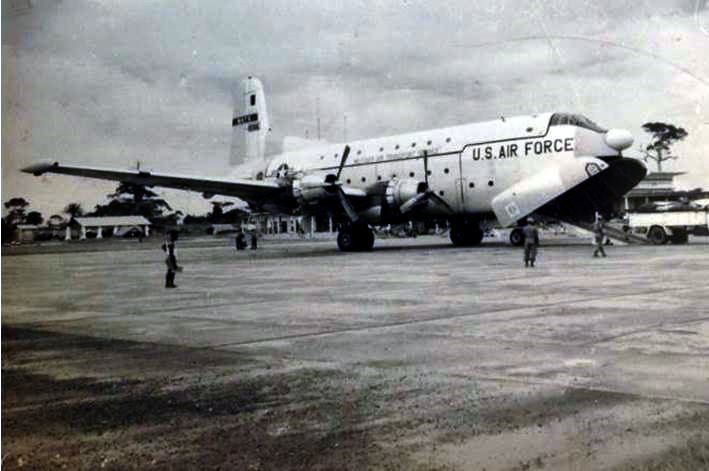 |
| USAF C124 Globemasters. |
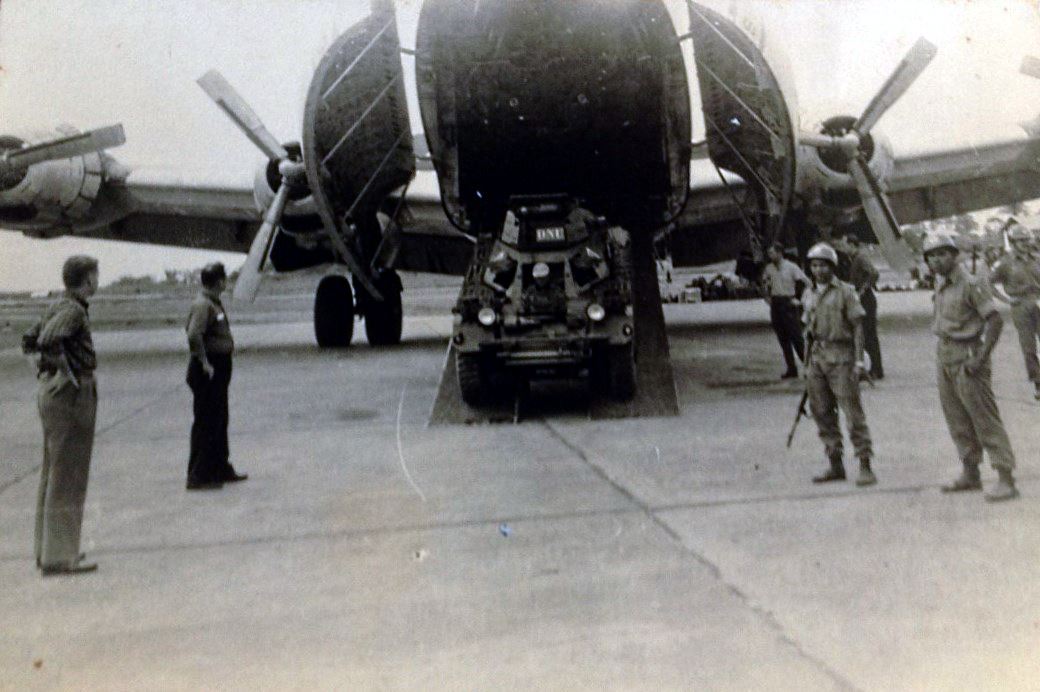 |
| Loading Ferret Scout Car. |
The Last Round Up
Kongolo was the strategic northern most town of Katanga. It had a strong garrison of Katangese forces. When Tshombe announced to the world that Katanga secession had ended, most rebels in Kongolo surrendered but there were rebellious factions who did not comply and were roaming the countryside. 'OPERATION FRIENDSHIP ' was launched to round up those rebellious soldiers on 17 Jan 1963. For this Operation, the MSF consisting of 2 RAMD (A and B Coys) plus C Sqn 2 Recce was placed under command of HQ 3 Nigerian Bde based in Kongolo.
At 0400 hours on 17 Jan 1963, the MSF column led by C Sqn 2 Recce departed Bukavu for the very long advance (over 1000 km) into Kongolo. On the second day a bridge gave way after all the Ferrets had crossed, but 2 RAMD together with the reserve fuel vehicles were caught on the wrong side. The consequence, C Sqn who was leading the advance soon ran out of fuel but by then it had moved very far ahead of the main column and was left stranded in the middle of nowhere, the next nearest town; Kabambare was about 50 km away. Some 30 km separated the leading Tp from the tail end Charlie which was No 1 Tp led by Siew Soo.
Meanwhile the broken bridge got repaired after several hours. The Infantry vehicles helped themselves refuelling with C Sqn reserve petrol meant for the Ferrets. This allowed them to continue the advance and to add insult to injury, overtook C Sqn and proceeded to the river crossing site. No 1 Tp spent the next three days by the roadside in the real physical heart of darkest Africa, with no fuel and no food. They survived on maize partly barter traded with the locals and we also acquired some elephant tusks using their limited Congolese francs. The next day a 3 Ton Bedford truck driven by Cpl Ong Chong Yen came to our rescue with drums of fuel. Once topped up the Ferrets roared to the river crossing site at River Luika, the boundary separating Katanga from Kivu Province.
A Coy commanded by Maj Rahman Khamis formed the vanguard in the advance to Kongolo. The leading Platoon commanded by 2nd Lt Tunku Abdullah Ibni Sultan Abu Bakar was fired upon by some Katangese. In the fleeting firefight there was no casualty on our side, it was not known if the Katangese suffered any as they disappeared into the bush. Later in the day, 60 Katangese surrendered with their weapons. The next day another one hundred surrendered.
C Sqn was tasked to patrol all the tracks in the Kongolo vicinity. The land here was dry and arid with little water. For three days; the Sqn went without a bath, on the fourth day there came across a beautiful river, the water was invitingly clear and the current did not appear fast flowing. Everyone was dying for good bath and stripped to their underwear, Siew Soo was the first to take the plunge. He jumped in and the next instant was pulled out by Major Asna who was about ten to fifteen feet on his left. The current was so deceptive, if not for Major Asna, Siew Soo would have been gone forever down the River of No Return in the Heart of Africa. To Major Asna (later Brig Gen, Dato); Siew Soo eternal gratitude !
On 2 Feb 1963 it was confirmed all surviving Katangese troops had formally surrendered and the Nigerian Bde was satisfied that there were no more groups of Katangese soldiers left. Mission accomplished, the MSF on 4 Feb 1963 headed for Kabalo where it boarded a train to Albertville and from there the familiar old journey by lake barge on Lake Tanganyika (Siew Soo 3rd voyage) to Kalundu near Uvira and up the mountainous road to Bukavu.
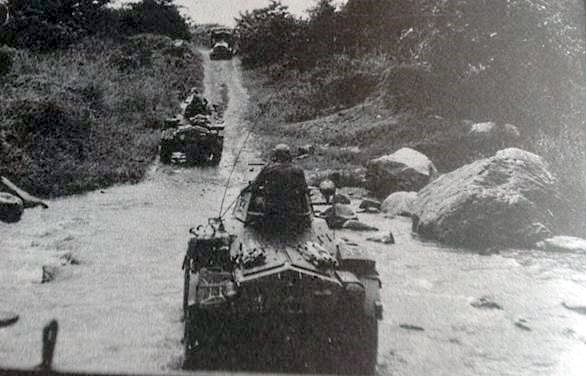 |
| The Mountainous road to Bukavu. |
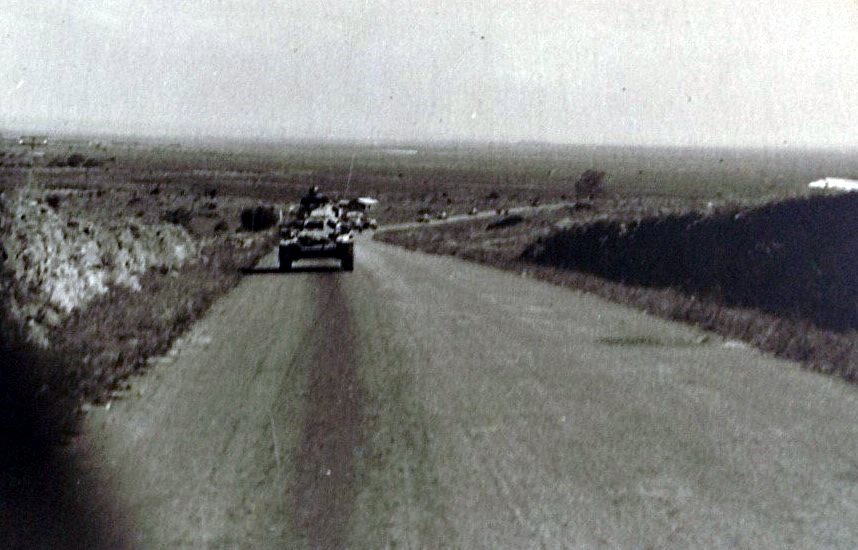 |
| The Plains of Bukavu. |
The Last Days of the Malayan Special Force
After 'Operation Friendship' the MSF returned to Bukavu for a welcome change of weather from the humid heat of northern Katanga. The minds of most personnel were focused on home after learning that C Sqn were to be the last MSF serving ONUC. The call of home was compelling for Siew Soo; it was difficult to describe the feelings unless one has served in such a force overseas. It was an ingenious way of cultivating patriotism and loyalty to the country irrespective of ethnicity.
As the Squadron were preparing to return home (by this time C Sqn had moved into Goma) the MSF was given one final mission. Neighbouring Uganda gained independence on 9 Oct 1962. A Federation of four kingdoms, Buganda the largest was showing secession tendencies and fighting the Central Government. Branded as terrorists, they we trying to cross over to the Congo. A request was made to ONUC to seal the common border. This Last Mission given to the MSF fell on C Coy 2 RAMD and No 1 Tp C Sqn 2 Recce commanded by Lt Tan Siew Soo.
C Coy commanded by Major Samad Sham had two young Platoon Commanders; 2nd Lt Ismail Omar and 2nd Lt Mohd Kassim (Lumumba) Ismail. They hit the northern trail on 15 Feb 1963, crossing the Congo/Uganda border at Ishasha River where one could immediately feel and see the greatly improved road conditions. Driving North-Easterly they passed some very well kept tea plantations, otherwise the route was through Queen Elizabeth National Park where elephants had right of way on clearly displayed road signs. They bivouacked the first night at the Park.
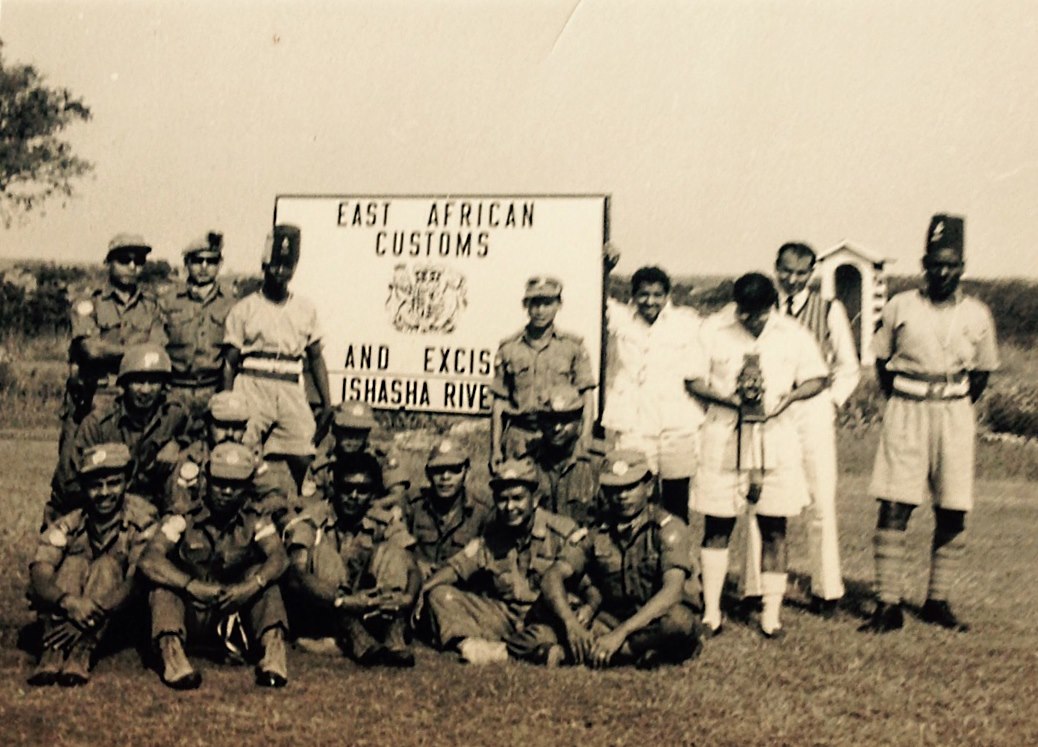 |
| The Officer on Siew Soo right is 2/Lt Ismail Omar wearing summer cap who later rose to become Chief of Defence Forces. |
 |
| No 1 Troop first night at the Queen Elizabeth National park. This is breaking of camp and ready to move. The 3 in the photo L to R: Tp Sgt Osman, Cpl Mahadevan and Tpr Tan Tai Beng. |
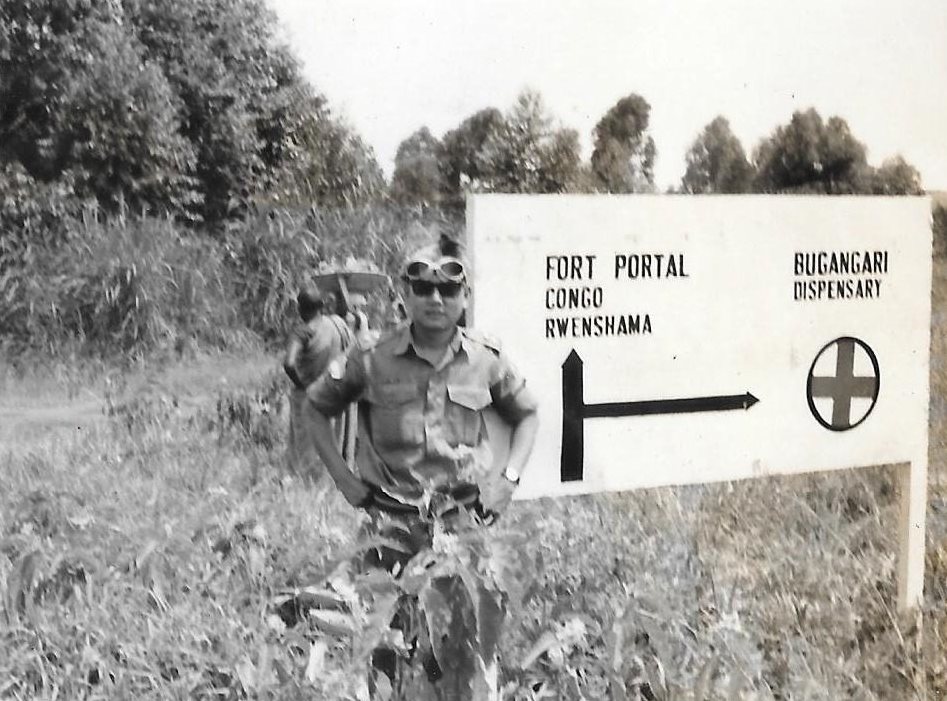 |
| Siew Soo at Uganda Border, 16 Feb 1963. |
At the Kazinga Channel connecting Lake George and Lake Edward, they headed North-West to reenter the Congo. They then parked themselves at the foot of Mt Ruwenzori or ‘Mountains of the Moon’ as the locals call it. A majestic looking snowcapped mountain standing at 16700 feet high, it is the third highest in Africa, after the more famous Kilimanjaro and Mt Kenya. Some seasoned climbers say the Ruwenzori is possibly the most beautiful because of its incredible vegetation. The magnificence of the Ruwenzori snowcapped top was most appreciated as it glimmers in the morning sun.
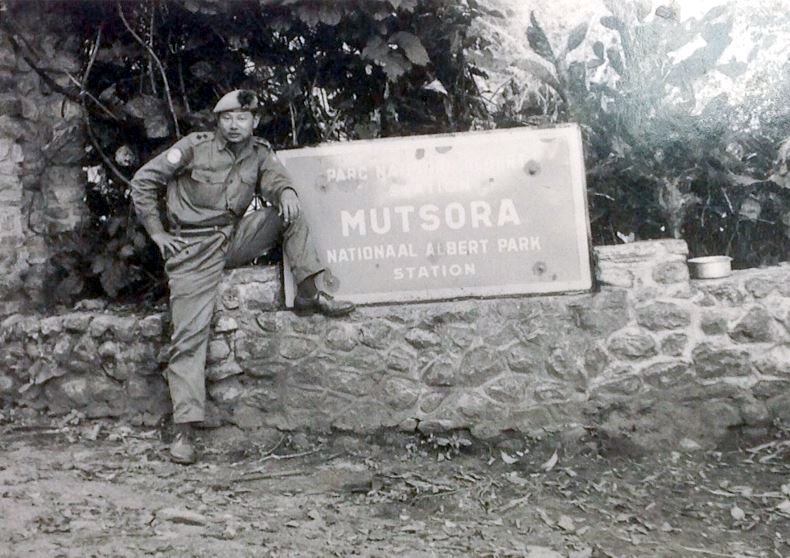 |
| C Sqn operated from here at the foothill of Mt Rwenzori during their last mission for the United Nations before returning home. |
Operationally, not much happened, apart from some road patrolling. There were arrests made but these were by the Congolese Police. They kept close liaison with the Uganda Police, two of their Special Branch officers had previously served in Malaya. Siew Soo first bivouac was along the main road going into Uganda, their home for several days by the roadside ! They then moved to Mutsora at the entrance to the Albert National Park. This Park was the size of the state of Selangor, a safari country where one encounter the wild animals associated with National Parks.
One day the CO of 2 RAMD, Lt Col Llyod Jones called on C Coy and from there decided to pay a visit to the Pygmies at the Ituri forest located some 80 km to the north in Orientale Province. Siew Soo volunteered to escort him and they arrived there in the afternoon, all the menfolks were away on hunting, and they did not get to meet any. The Pygmies are reputed to be the first people of Africa, the Bantu came later.
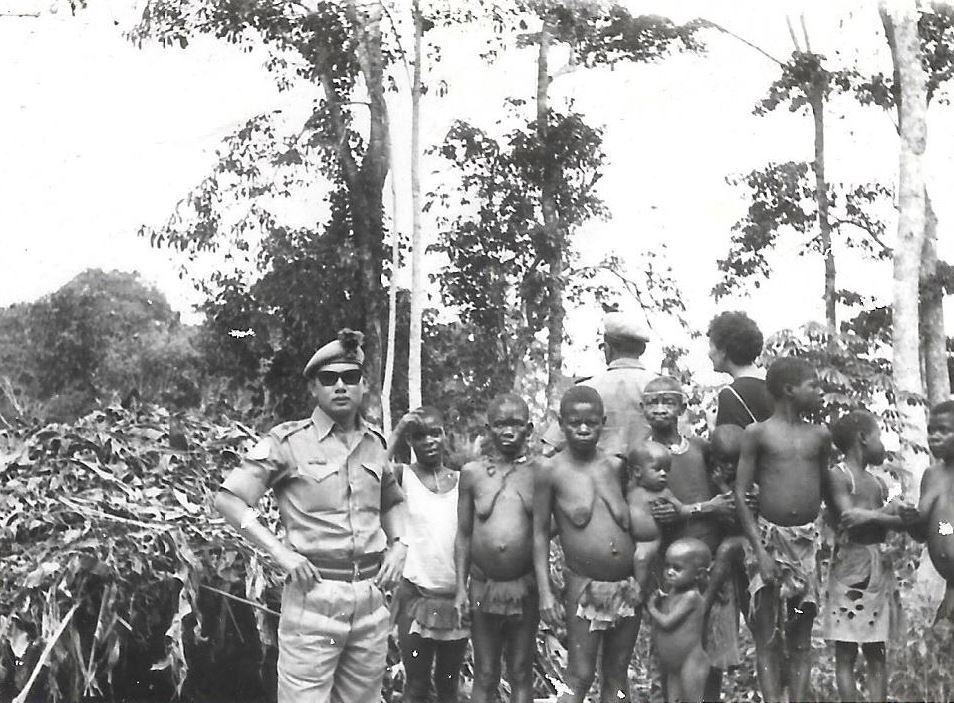 |
| A rare visit to the Pygmies in the Ituri Forest, Orientale Province in February 1963. |
In early March, C Coy 2 RAMD with No 1 Tp C Sqn 2 Recce completed the final task for ONUC and returned to Goma. C Sqn had completed their nine months tour of duty. The new Federation of Malaysia was barely six months away. Confrontation by Soekarno against the new Federation was brewing. The final exit of the MSF was therefore inevitable. By the first week of Apr 1963 all MSF vehicles totalling 117 were despatched to Dar-es Salam via Kigoma by train led by Lt Tee Bua Bian. On 10 Apr 1963 after completing almost ten months of service the last MSF consisting of 2 RAMD (minus D Coy) and C Sqn 2 Recce bade farewell to the Congo and ended a glorious chapter of our involvement with the United Nations.
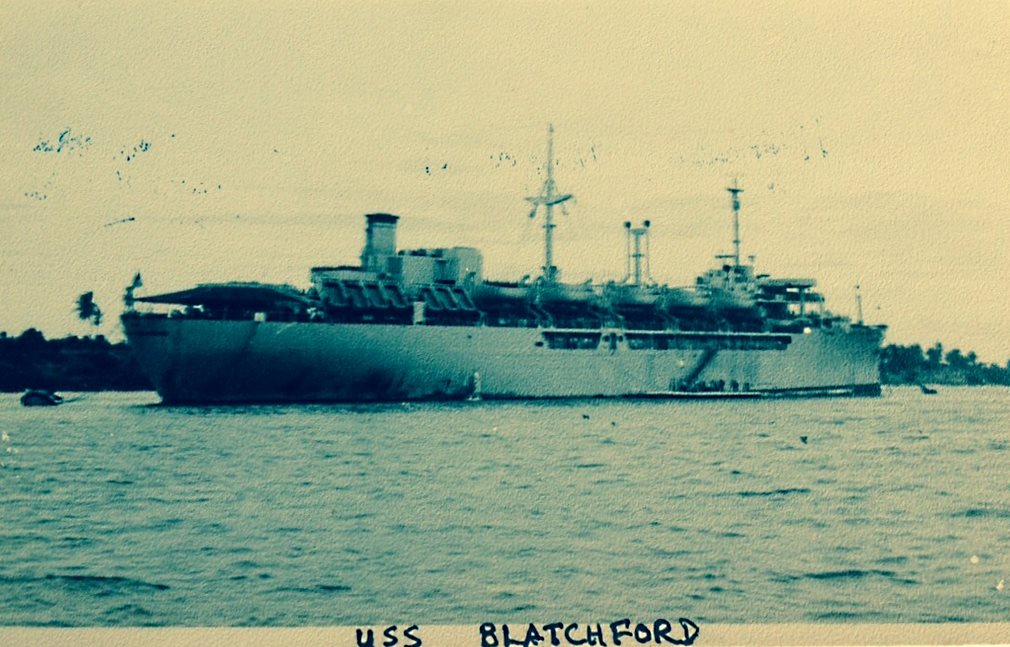 |
| USNS 'BLATCHFORD' Troopship. |
A fully air-conditioned ship that ferried the majority of the MSF to and fro the Congo. Apart from the ELTINGE, a sister ship which ferried 2 Recce and the LSTs of the original MSF, this was the Troopship of the MSF. Siew Soo voyaged in it three times, the first time from Dar-es Salam and then to and from Mombasa.
MSF Report Card
This tribute to the Malayan Special Force by the UN Supreme Commander said it all. Not many who had served ONUC are aware of this. In the Congo Mission, it should find a place of pride.
The text of the Report of General Sean McKeon, Commander of the UN Forces in the Congo to the Federation Government.
"Having now completed 12 months service with the United Nations Force in the Congo, I consider that I should review the part played by the Malayan contingent in the Congo operation.
I do this in order to pay full tribute to the excellence of their achievements in many places throughout the Congo in which they have served with such distinction.
We have employed the Malayan troops in Leopoldville, Bukavu, Goma, Kamina, Elisabethville, Stanleyville, Kindu and elsewhere.
To most of these places they were sent because of the fact that I could always depend upon them to render a first class account of them and particularly to restore situations which appeared to be getting out of control.
In this regard the part played by the Malayan Contingent in Kivu Province and particularly in the Maniema district deserves special mention.
This Maniema district was for a very long time one of the most troublesome areas of the Congo. The perseverance, skill, endurance and friendliness of the Malayan troops soon brought this situation back to normal.
This task was accomplished only by the making of tremendous sacrifices on the part of the Malayan troops.
Some patrols into this district were of seven or eight day’s duration and in fact in many cases even longer. During these patrols, the troops endured the severest hardship--lack of sleep, lack of water and general fatigue over very rough terrain in very unfriendly surroundings.
Their efforts, however, ultimately resulted in establishing excellent relations with the Congolese National Army and the local population alike. This has been characteristic of their achievements everywhere they have gone throughout the Congo.
These resulted from the fine example they set by their high standards and their readiness to make friends and resolve situation by pacification wherever they go.
In this regard, they have shown an appreciation and understanding of their role in the United Nations operation in the Congo which has been second to none.
Our enquiries into the recent tragic events at Kindu have clearly indicated that the Malayan company stationed there did not have information in sufficient time to intervene to prevent the killing of the 13 airmen.
Had they had the time or opportunity to intervene, I am satisfied beyond any possible doubt that despite their inferiority in numbers, they would have taken instant and vigorous action to save the lives of the airmen.
No contingent in the Congo would have been quicker to come to the rescue of lives in danger, whether Congolese or other nationality. This they demonstrated to us time and time again.
May I conclude by congratulating your Government, your people and your army on the excellence of the units they have provided for the Congo operation and I sincerely hope that the Malayan Government can see its way to continue to provide a Malayan contingent until the Congo operation is brought to a successful conclusion."
Sean McKeon
Lieut General,
Commander, ONUC Forces.
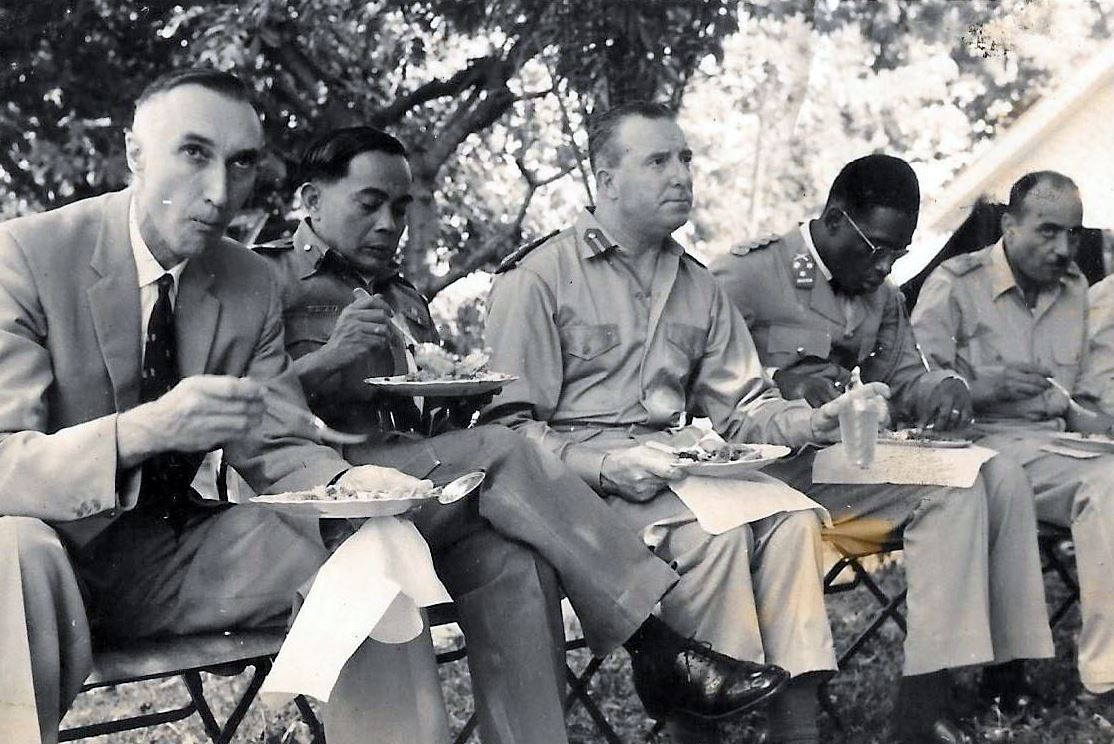 |
| VIPs at MSF Officers’ Mess having buffet lunch. L to R: Mr Scott, UK Ambassador to Congo, Brig Tunku Osman, Lt Gen McKeon, Supreme Commander ONUC, Maj Gen Mobutu and Col Lasmar, Brigade Commander Tunisian Brigade. |
For Siew Soo personally, the Report is not only nostalgic but emotive as well, as he was intimately involved during the first nine months. Reading some of the passages, images immediately flashed back as if those events occurred only yesterday when in fact they were more than half a century ago. These were so deeply etched in his mind perhaps because they occurred in the formative years of his Army career and they happened in darkest Africa ! Truly an experience to be treasured.
Early Years
The Templer's 12 were iconic but 4 years 3 months later the Country had established its own little Sandhurst. In pre independent, colonial Malaya the product of the 1st Intake Regular Officer Cadets can be classified as 'POME ' (Product of Mother England). All military instructors right down to Sergeant Majors were British, the academic staff were seconded from RMA Sandhurst. Medium of instructions were all in English. It was like a little part of United Kingdom got transplanted in Port Dickson.
The formation of the Federation Military College (FMC) was another brainchild of General Sir Gerald Templer who in 1953 had conceived a long term objective of FMC consisting of two wings: Boys Wing and Pre-OCTU Wing, the latter for training Potential Officers prior to being sent to UK for further military training to become officers. With Independence looming Pre-OCTU Wing was expanded into the Cadet Wing and Regular Intake One was born on 2 Jan 1957.
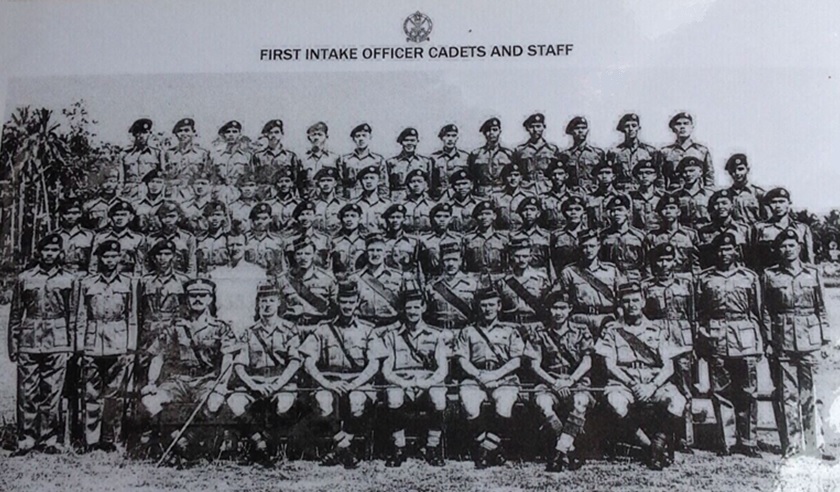 |
| Group Photograph of Intake One Cadet Wing with the British instructors, only one Malayan (Sarawakian) Lt Ngu Kuan Kee. This Group can be considered "the Father of Cadet Wing". |
During the previous day on 1 Jan 1957, on the dusty, wind-blown Auster airstrip at the 5th Mile Port Dickson Coast Road, sandwiched by the historical buildings that accommodated the experimental company of the Malay Regiment in 1933, came 54 young men from all parts of Malaya and Singapore including 21 direct from the Boys Wing of the College. When training began on 2nd January, the 54 young men now called Officer Cadets pursued a two year intensive military course together with Cambridge Higher School Certificate studies towards achieving commissions in the Federation Army as the Malayan Army was then called.
In the process 11 went for further training to Sandhurst, United Kingdom; 5 went to Portsea, Australia in two batches and 4 dropped out. Eventually 34 of them made history when they received their commissions from the first Yang Di Pertuan Agong Almarhum Tuanku Abdul Rahman Ibni Almarhum Tuanku Muhammad; for the first time in the history of the country on 13 Dec 1958. It was a spectacular First Sovereign Parade the nation had ever witnessed. Among the dignitaries were the Deputy Prime Minister cum Defence Minister; Dato Abdul Razak bin Hussein and others.
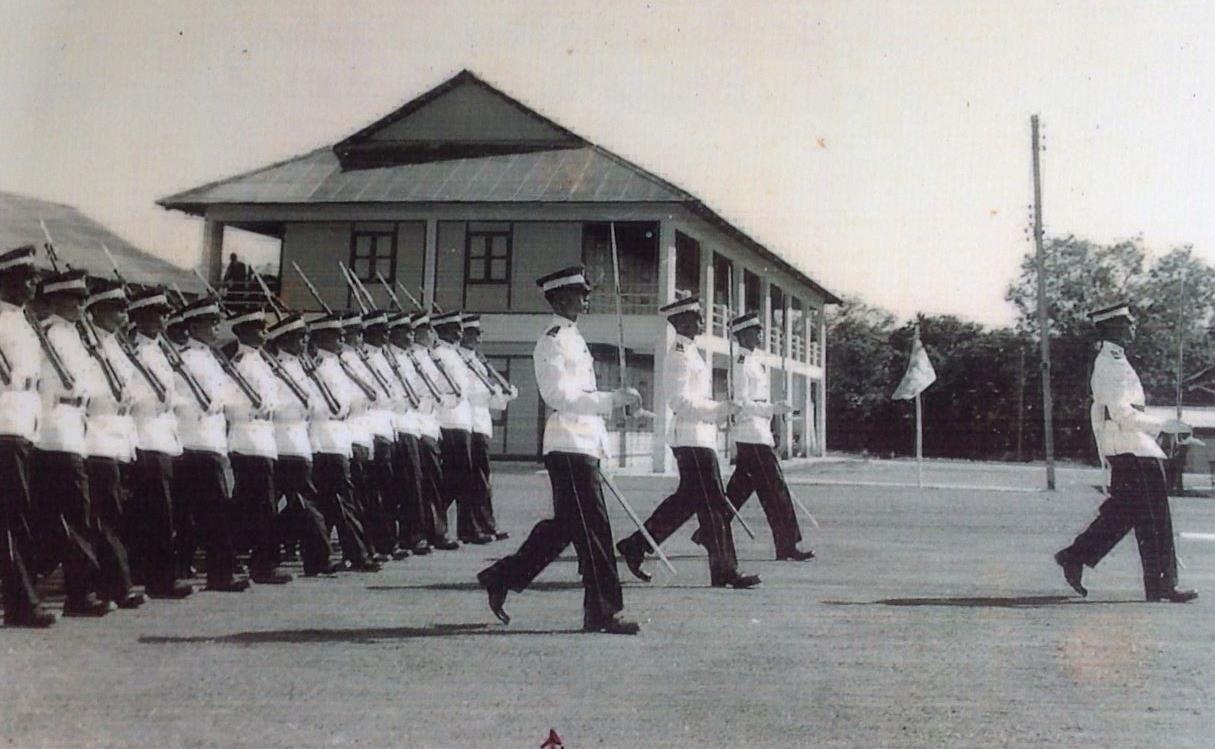 |
| The Sovereign Parade of 34 Officer Cadets graduating on 13 Dec 1958 marked the historical beginning of Cadet Wing, Royal Military College. 2/Lt Tan Siew Soo is 3rd Detachment Commander. |
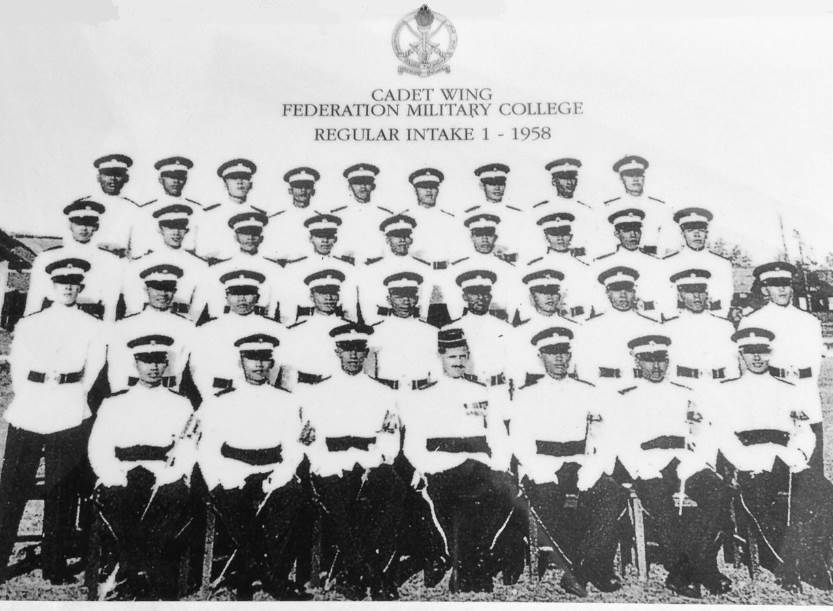 |
| Sovereign Parade. Sword bearers in the front row seated L to R: 2/Lts Lee Ah Pow, Aziz Saif, Anthony Loone, Maj Stafford (OC), 2/Lts Malik Nazir, Syed Alwee and Tan Siew Soo. |
It is noteworthy that in this group of 54 Cadets, there was a significant total of 18 Chinese Cadets - 30%. The 34 Cadets that eventually graduated on 13 December 1958 consisted of 11 Chinese officers again a significant 30%. It is with deep sadness to note that 9 of the original 18 officers are no longer with us. Gone but not forgotten:-
1. Col Hew Kim Yew, Signals
2. Maj lm Min Chow, Service Corps
3. Col Long Seh Han, Service Corps
4. Lt Col A C Loone, Ranger
5. Maj Ong Kah Yoke, Michael, Service Corps
6. Maj Soh Kim Chwi, Norman, Service Corps
7. 2nd Lt Tan Siew Leong, Richard, Signals
8. Lt Col Teoh Say Chee, Armour
9. Tang Hong Whye, Peter, Singapore Infantry Regiment.
The old timers still around:
1. Col Chan Meng Yin, Service Corps
2. Col Hew Kiang Thiam, Henry, Ordnance
3. Lt Col Tan Siew Soo, Armour
4. Lt Col Wong Siew Ngan, Ordnance
5. Lt Col Yuen Kum Wah, Paul, Ordnance
6. Maj Khoo Ewe Kee, Frank, Armour
7. Maj Lee Ah Pow, Armour
8. Maj Lee Voon Tet, Joe, Armour
9. Maj Sam Tat Yau, Johnny, Service Corps.
Siew Soo was born on 22 Nov 1938 at Georgetown, Penang. He had his early education in Bukit Mertajam High School before joining Boys Wing, FMC.
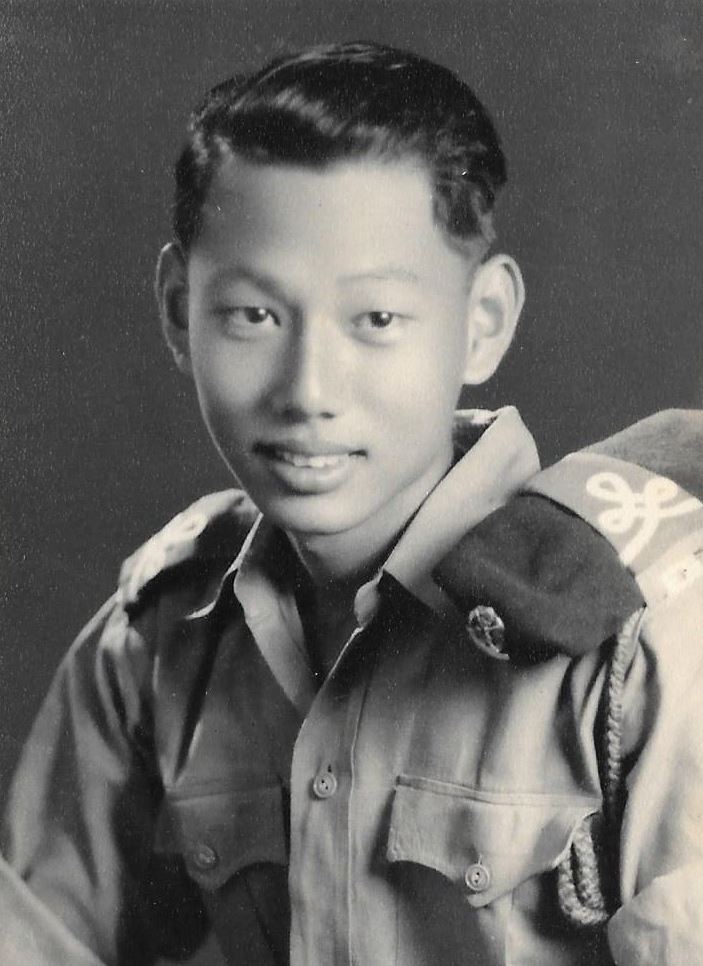 |
| 200590 Boy Tan Siew Soo at FMC, Port Dickson 1954. |
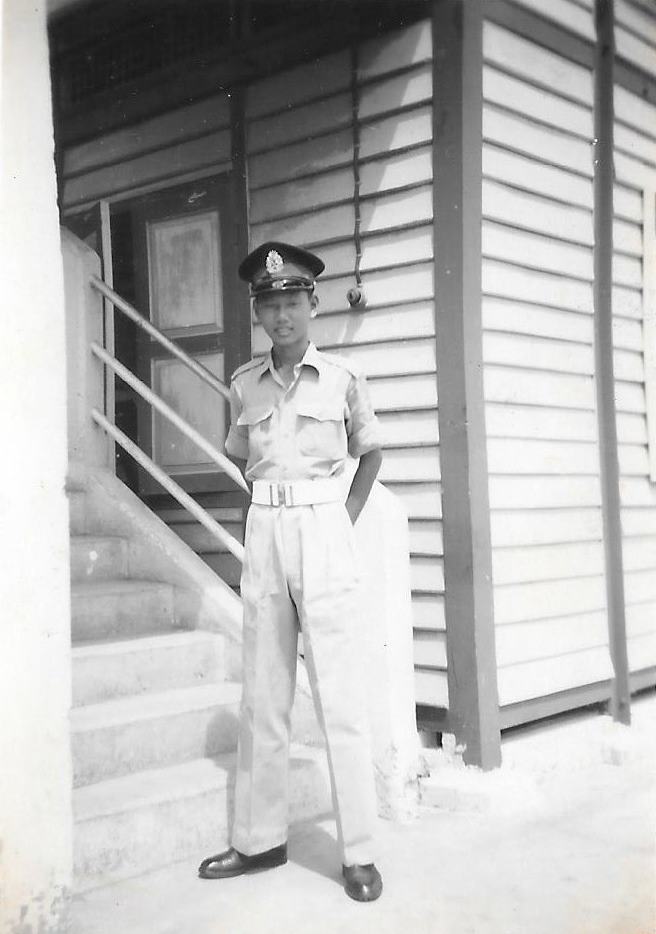 |
| JUO Tan Siew Soo Boys Wing FMC 1956. |
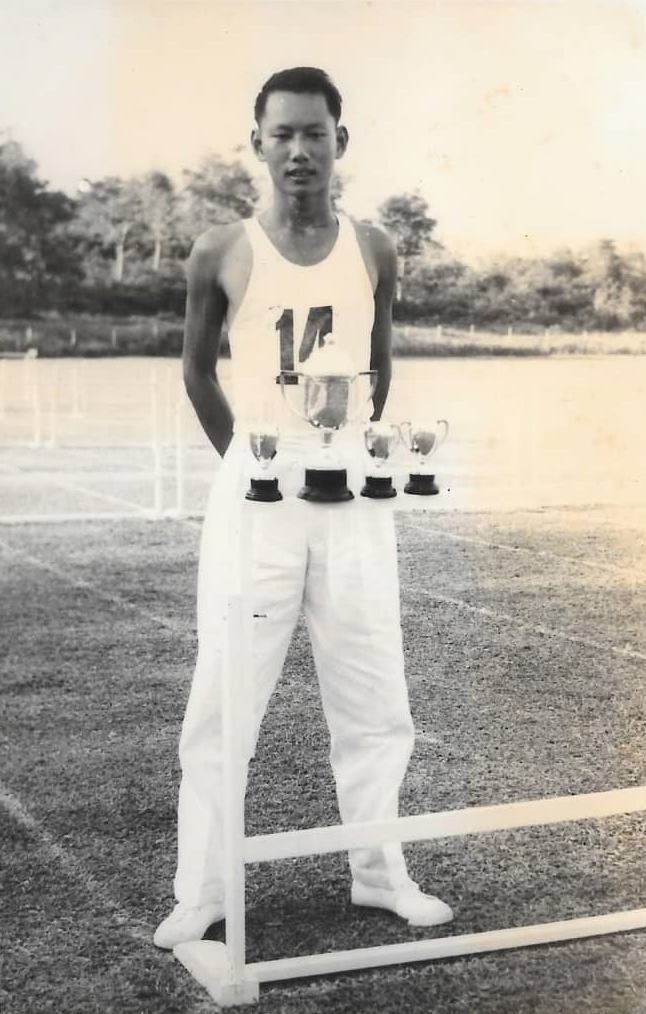 |
| First Victor Ludorum Cadet Wing, FMC 1957. Siew Soo was Champion athlete in 1957. To be Victor Ludorum one must win in both track and field events. The FMC of the era did not award prizes for second or third placing, only the winner got a trophy. Siew Soo collected three; 120 yards hurdle, long jump and 440 yards race. |
On 2 Jan 1957 he joined the 1st Intake Regular Officer Cadets and was commissioned on 13 Dec 1958. 2nd Lt Tan Siew Soo was given command of No 1 Sabre Troop, C Squadron, Federation Armoured Car Regiment (FACR) in January 1959, a first for both; Siew Soo and C Sqn which was raised in 1958. C Sqn became operational in Mar 1959, based in Hobart Camp, Gurun until Oct 1959 where a troop was deployed at Kroh and Titi Akar rotating monthly.
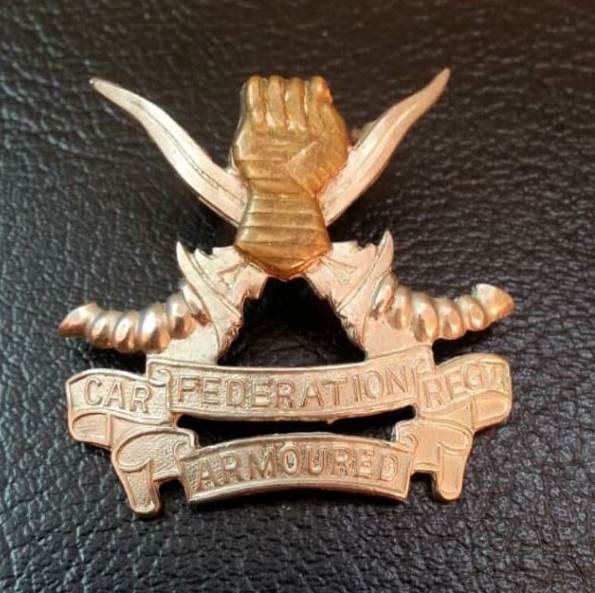 |
| FACR Cap Badge. |
| 2nd Lt Tan Siew Soo at Hobart Camp, Gurun, Kedah in 1959. The Daimler Scout Cars, the predecessor of the Ferrets were the workhorse of the Squadron. Each Sabre Troop had one Daimler Armoured Car armed with a 2 Pounder Gun, 2 X Scout Car and a Land Rover carrying 8 X Assault Troopers. |
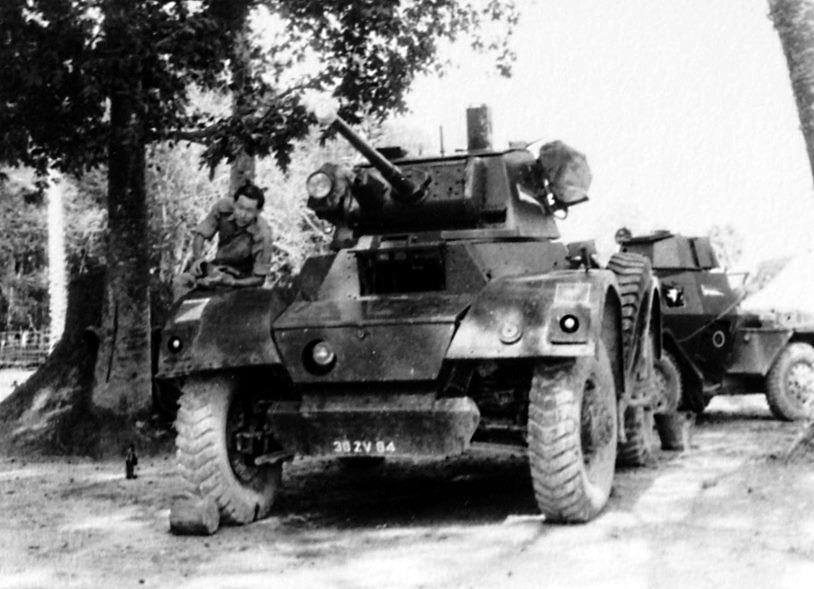 |
| Picture taken in April 1959 at Titi Akar, a small Siamese village in Pendang, Kedah. |
Service Milestones
First Troop Leader (Chinese) of No 1 Tp, C Sqn, FACR in January 1959 until April 1963.
First Commanding Officer (Chinese) of 4th Regiment, Royal Armoured Corps 1982-1983.
Served with the UN in the Congo (ONUC); 1st Tour (Sep 1960 to Jul 1961); 2nd Tour (Jun 1962 to Apr 1963).
| 1954 - 56 | Boys Wing, FMC. |
| 1957 - 58 | Cadet Wing, FMC. Intake One Regular. |
| 1959 | 2nd Lt 1959, involved for seven months during the First Emergency on border operations in Kedah and Northern Perak. |
| 1960 | FACR redesignated 2 Recce. July 30th took part in End of Emergency (victory) Parade in Kuala Lumpur. |
| 1960 - 61 | Sep 60 to Jul 61 selected to serve in the First UN Mission in the Congo (ONUC). |
| 1962 - 63 | June 62 to Apr 63 service with ONUC 2nd tour. |
| 1963 - 64 | Confrontation . As Sqn 2/IC and later acting OC Support Sqn 2 Recce based in Sungala Camp, Port Dickson tasked with the security of Negri Sembilan coastline up to Malacca Cape Rachado. One TA mobilised Coy was attached under comd Sp Sqn and deployed at various key points and strategic locations along the coastline. |
| 1965 | Staff Captain A HQ 2 Bde, Ipoh. |
| 1967 | GSO 3 Air/Int HQ 5 Bde in Labuan/Tawau. |
| 1968 - 70 | OC B Squadron 1 Recce involved on Border Operations in Kroh and Changloon during the Second Emergency. Also May 13 Operations in Malacca as the military commander of Alor Gajah District Operational Council member. |
| 1970 | SO2 Log (Mal) from January to July during Five Power Exercise Bersatu Padu at HQ in Kuala Lumpur and Dungun, Trengganu. |
| 1970 - 73 | SO2 Log HQ 2 Div, Sungai Besi. |
| 1973 | Staff College Haigate. |
| 1974 - 75 | Bn 2/IC 4 Renjer in Sibu. |
| 1975 - 76 | Bn 2/IC 3 Renjer in Taiping. Wrote the history of the Battalion from its formation till 1975 in the format of magazine. |
|
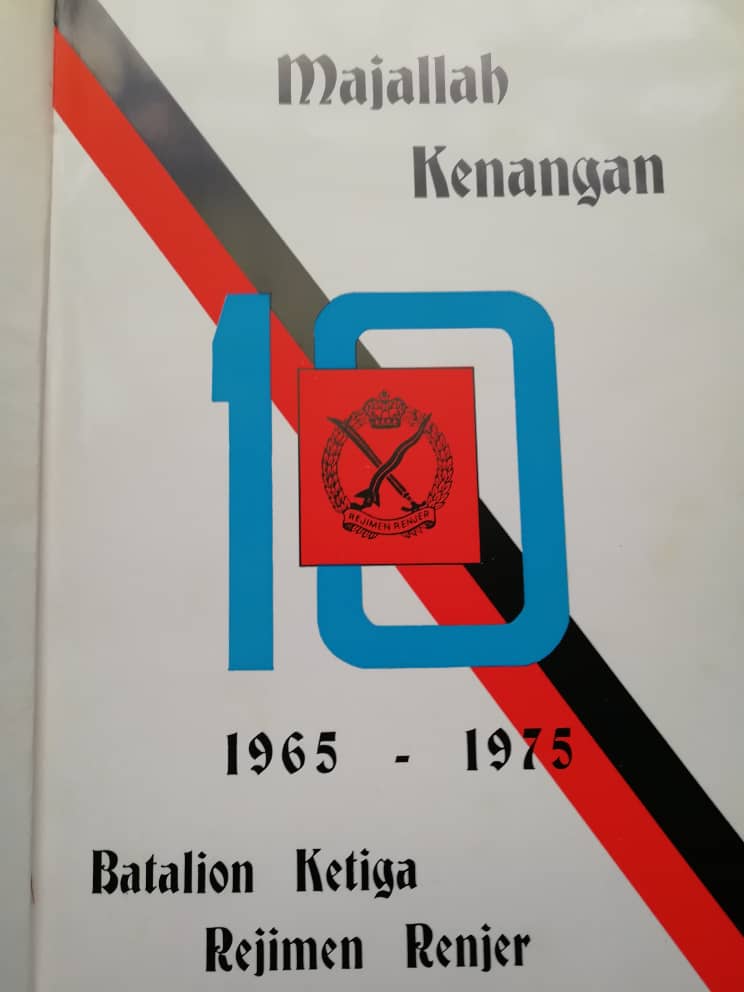 |
| 1976 - 78 | GSO 2 Ops HQ KL Garrison. |
| 1979 | 2/IC Reserve Officers Training Unit (ROTU) University Malaya. |
| 1980 | DS Staff College Haigate.
(Prior to promotion sent to England for a study tour at the Royal Armoured
Corps Centre in Bovington, Dorset. Visited 2 Cavalry affiliated Regiment
13/18 Royal Hussars and attended a formal Mess Night. Also visited the Scorpion Tank factory at Coventry and the Vickers Tank factory in Newcastle Upon Thyne.) |
| 1982 - 83 | CO 4 Cavalry Regiment. Raised the Regiment at Kuantan and moved to Sungei Petani in 1983. At the Corps CO Conference in 1982, wrote the history of the Cavalry Corps from inception until 1980 to commemorate the Army 50th Golden Anniversari in Match 1983. |
|
 |
| 1984 - 86 | GSO1 SPEKA (Senior Officers School) in Sebatang Karah, Negri Sembilan. |
| 1987 | SO1 log, Army Inspectorate Team, MINDEF. |
| 1988 - 90 | SO1 Log, HQ Army Mindef.
(During this period visited the Australian Ministry of Defence at Canberra and other logistic units in Sydney and Melbourne. The following year visited the NZ ministry of Defence in Wellington, including trips to Christchurch and Auckland.) |
Honours and Awards
| 1980 | AMT (Ahli Makhote Trengganu). |
| 1985 | KMN. |
| 1989 | KAT. |
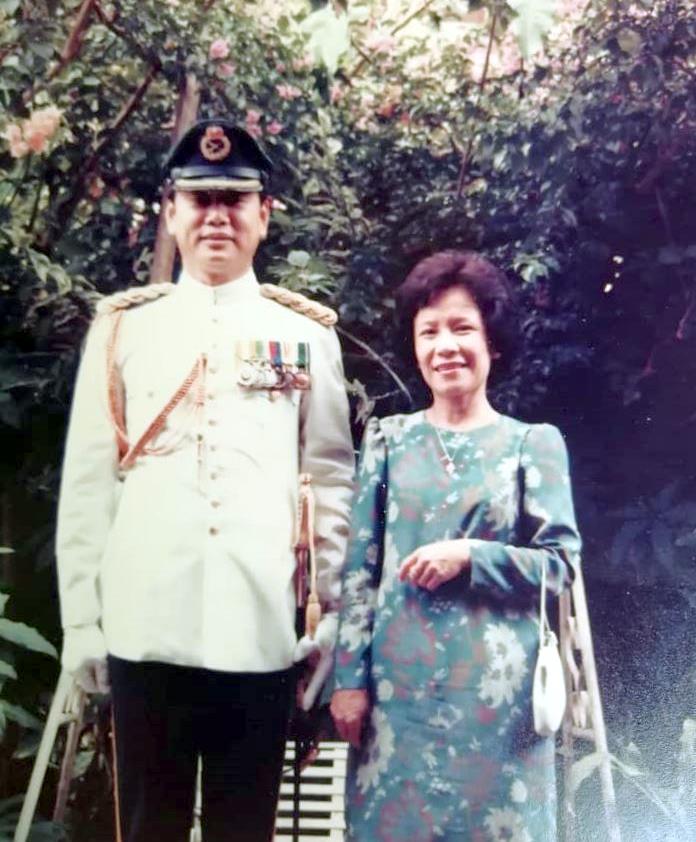 |
| Siew Soo and Catherine at KMN award, 1985. |
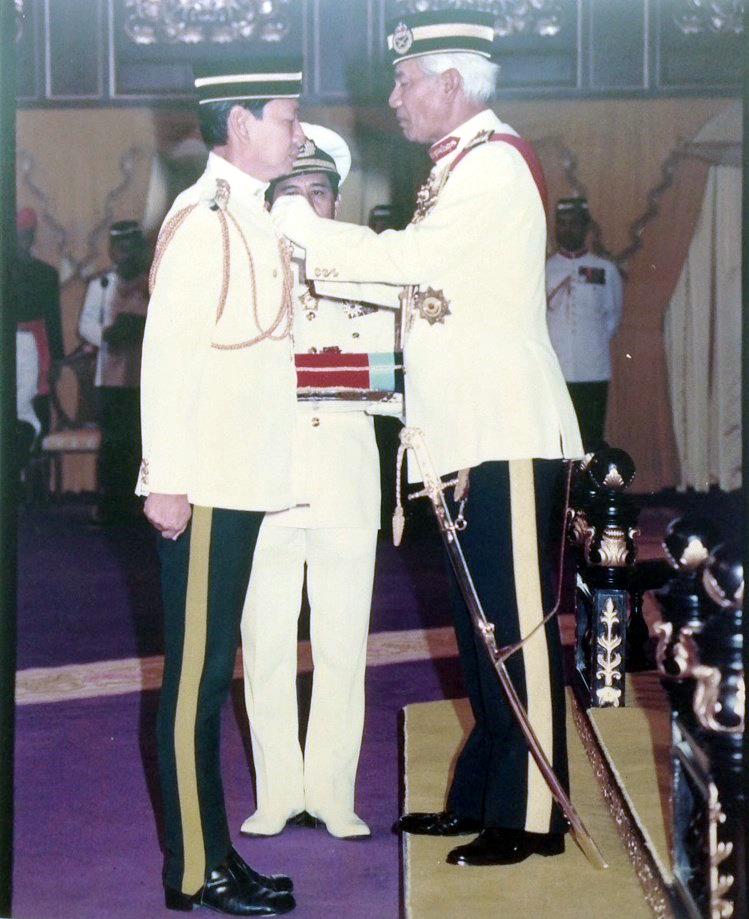 |
| Receiving KAT from DYMM Yang DiPertuan Agong, 1989. |
Conclusion
Lt Col Tan Siew Soo (Rtd) Regt Number: 200099 retired from the Malaysian Army on 22 Nov 1990 after serving the King and Country with pride and dedication for 33 years. Siew Soo is married to Catherine Yeoh Siew Hong and they are blessed with 3 children (Two boys and One girl) and 3 grandchildren (Two boys and One girl). They currently reside in Taman Melawati, Selangor. MACVA is very proud of Siew Soo achievements and his sacrifices for King and Country. We wish this him good spirit and good health in enjoying his well-deserved retirement with his family.
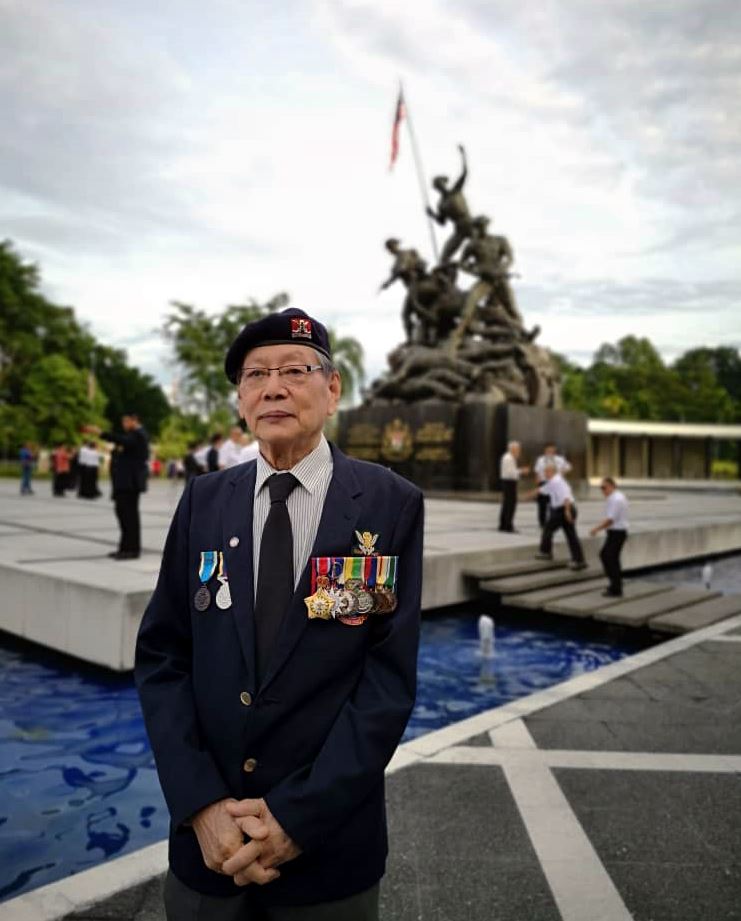 |
| Siew Soo at Tugu Negara, 31 Jul 2018. |
Recorded for MACVA Archives
Maj Wong Kwai Yinn (Rtd)
21 Sep 18














